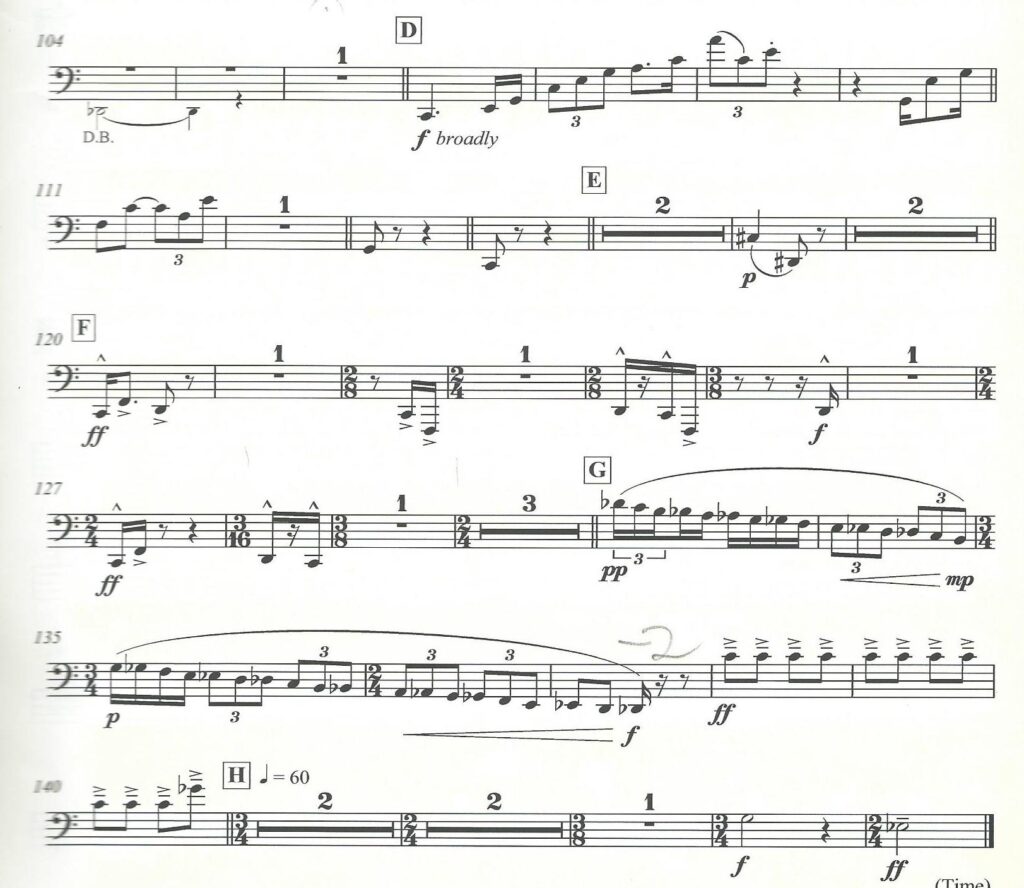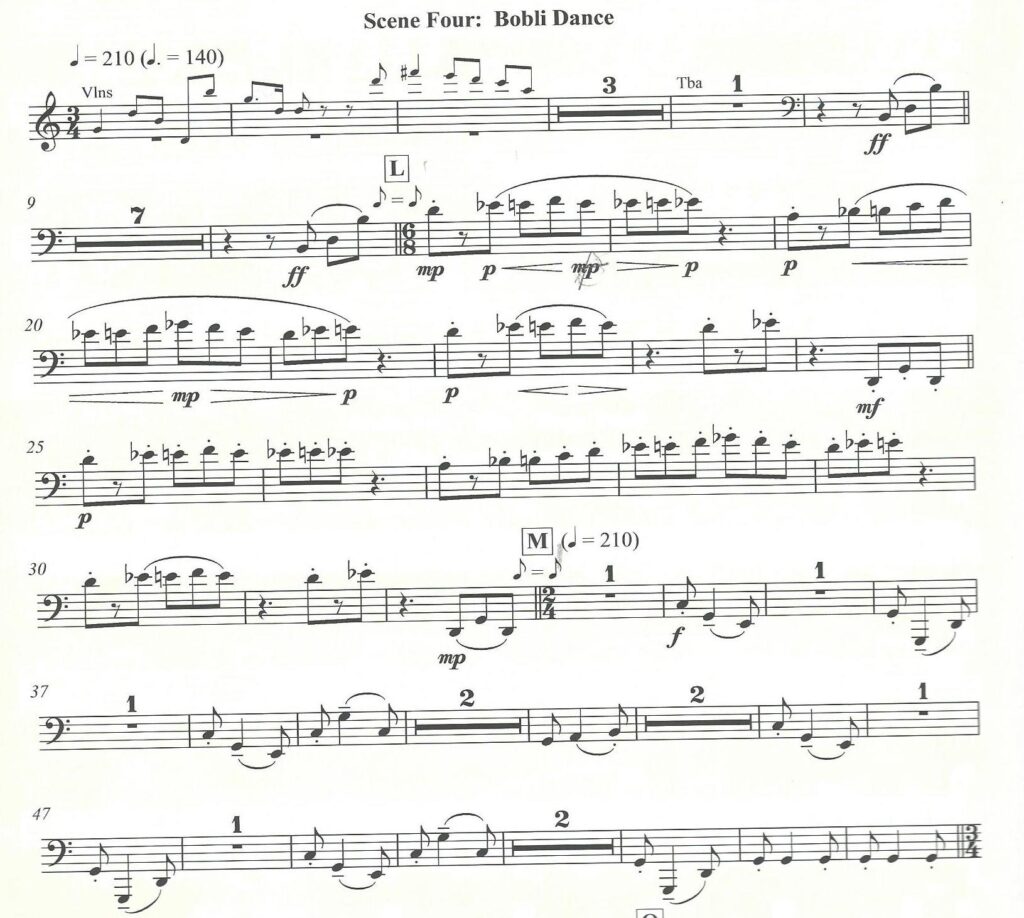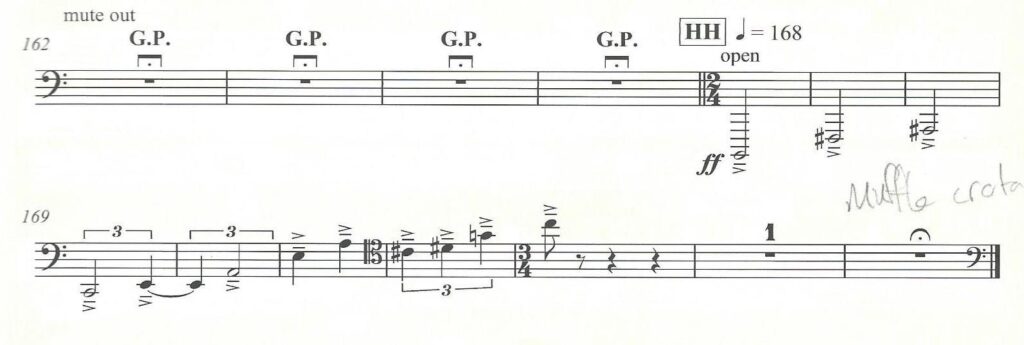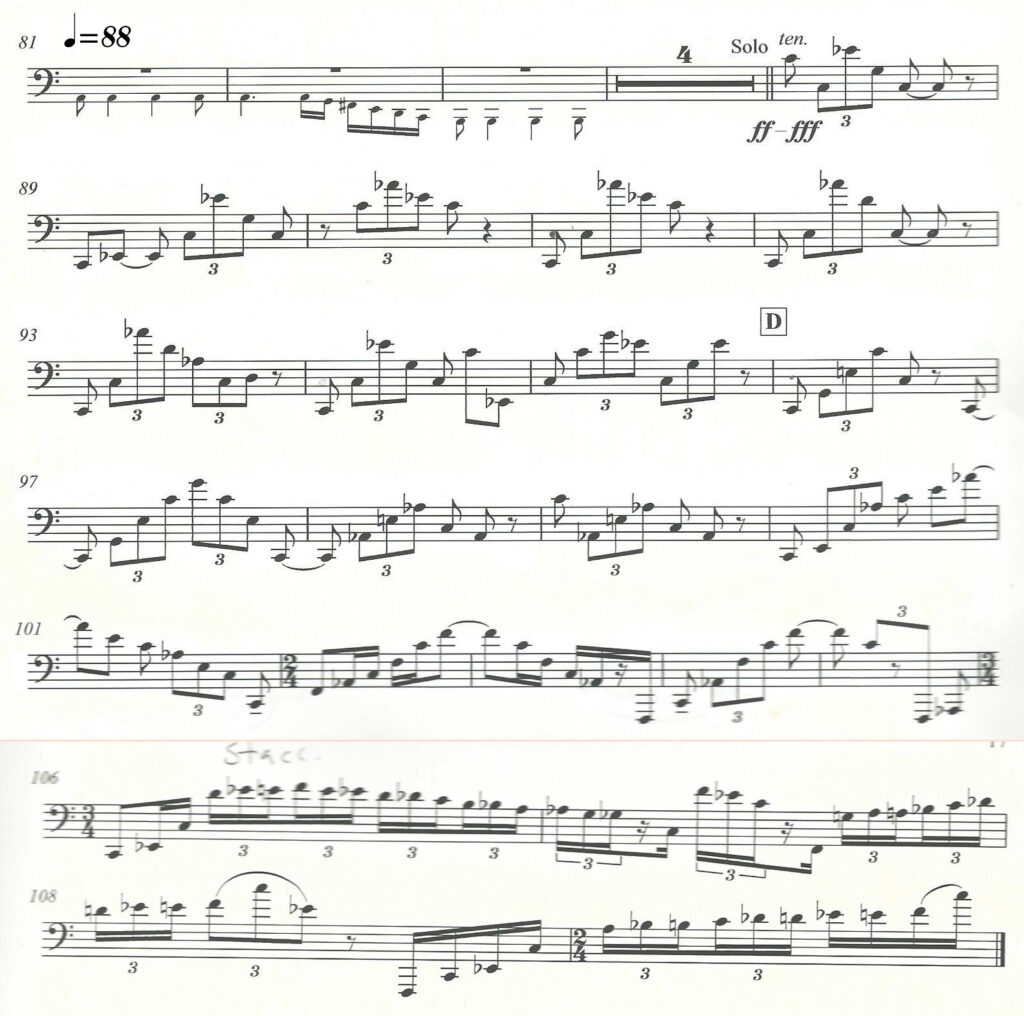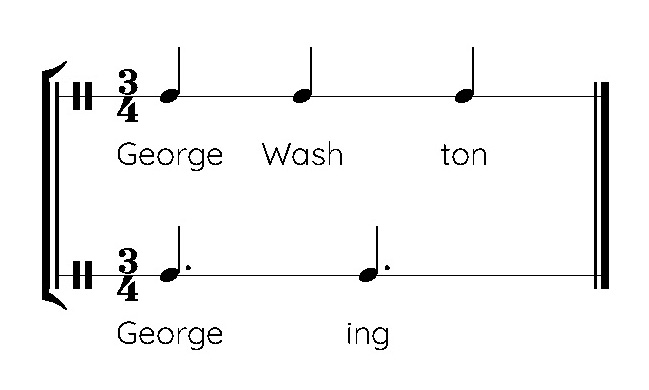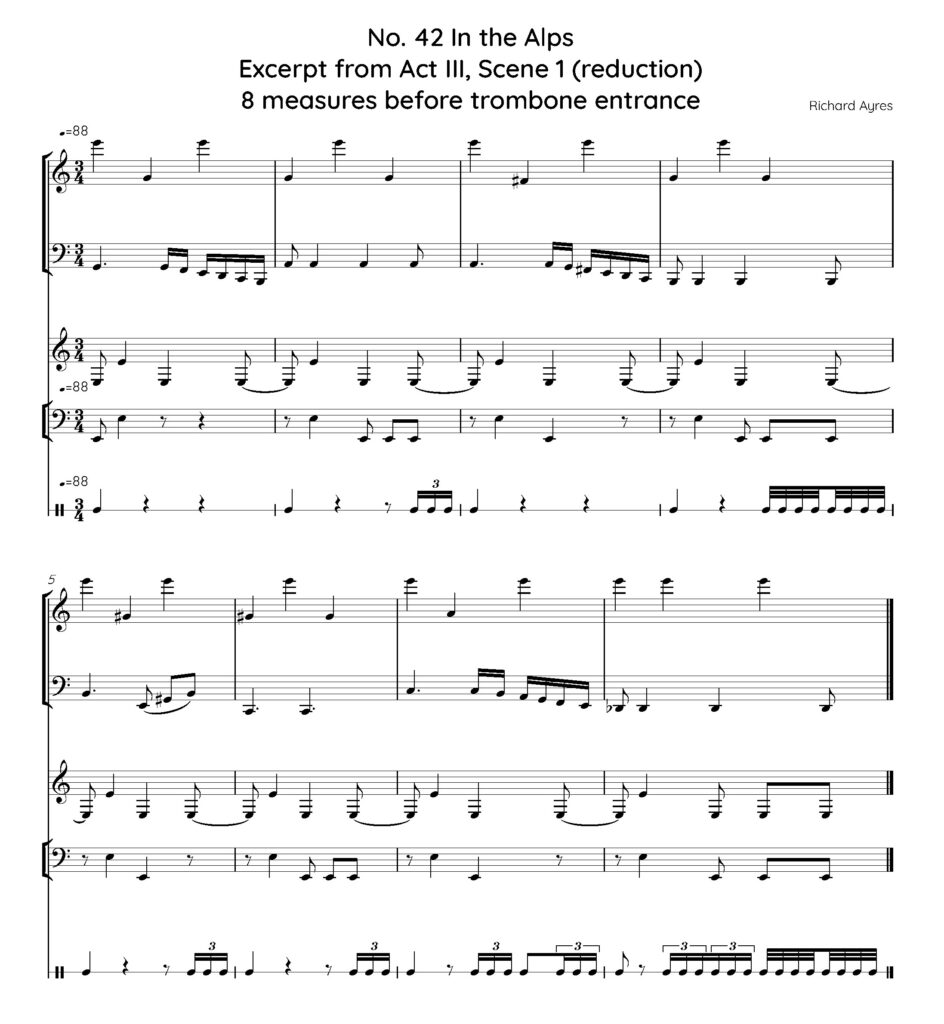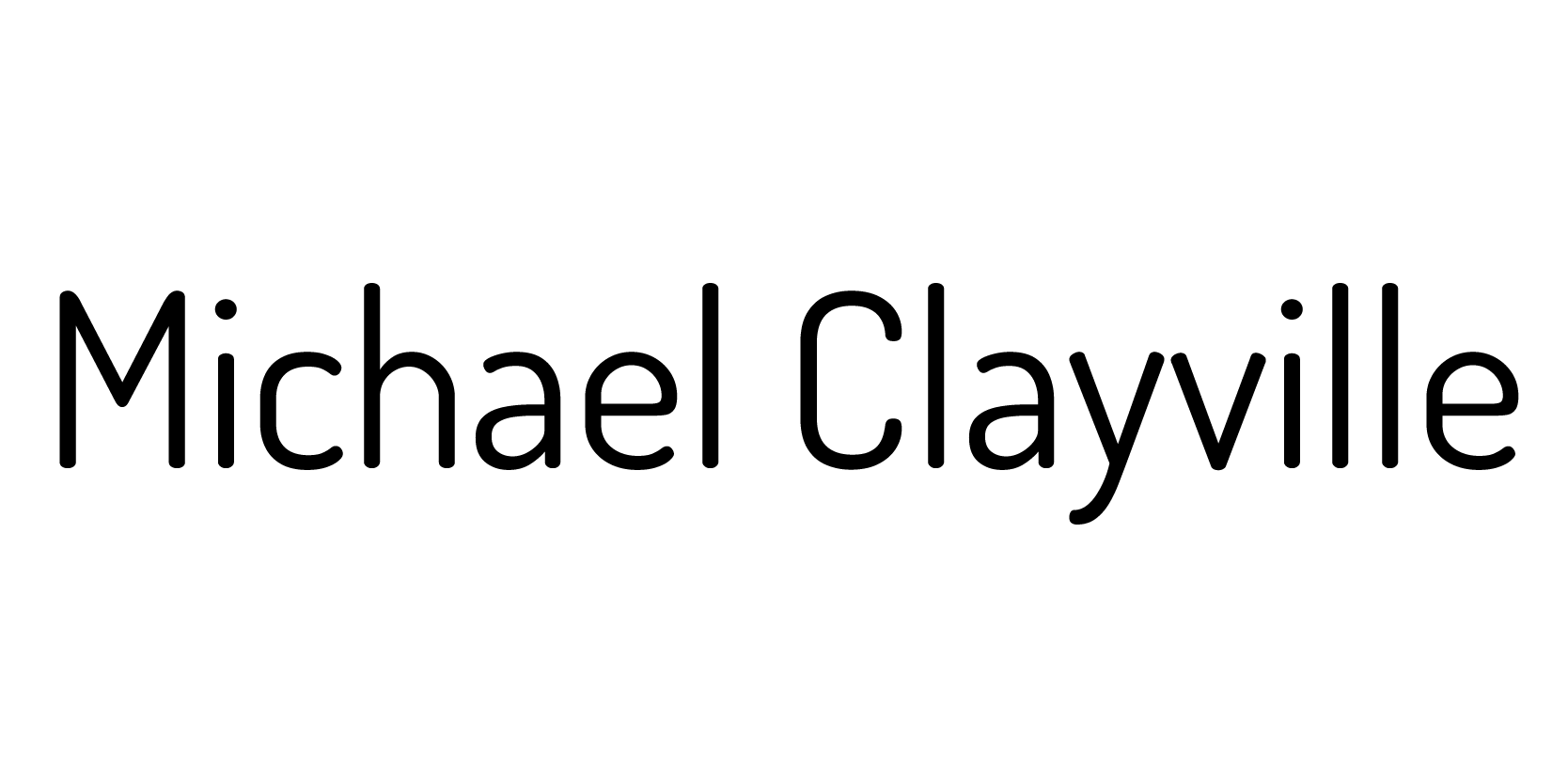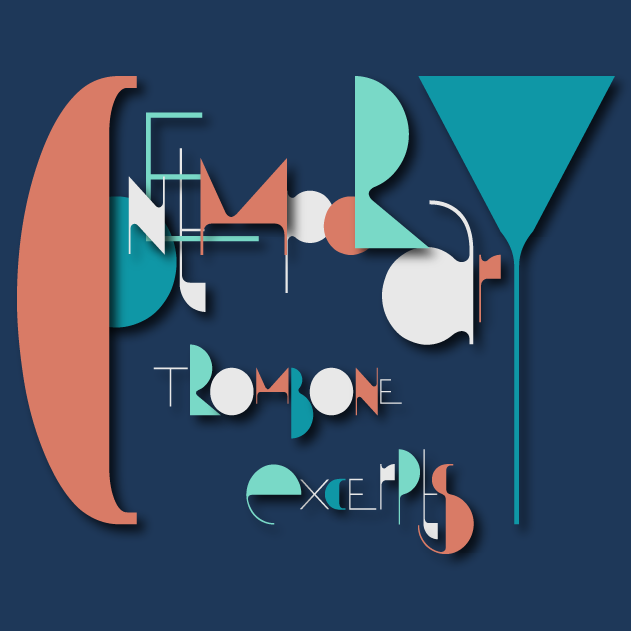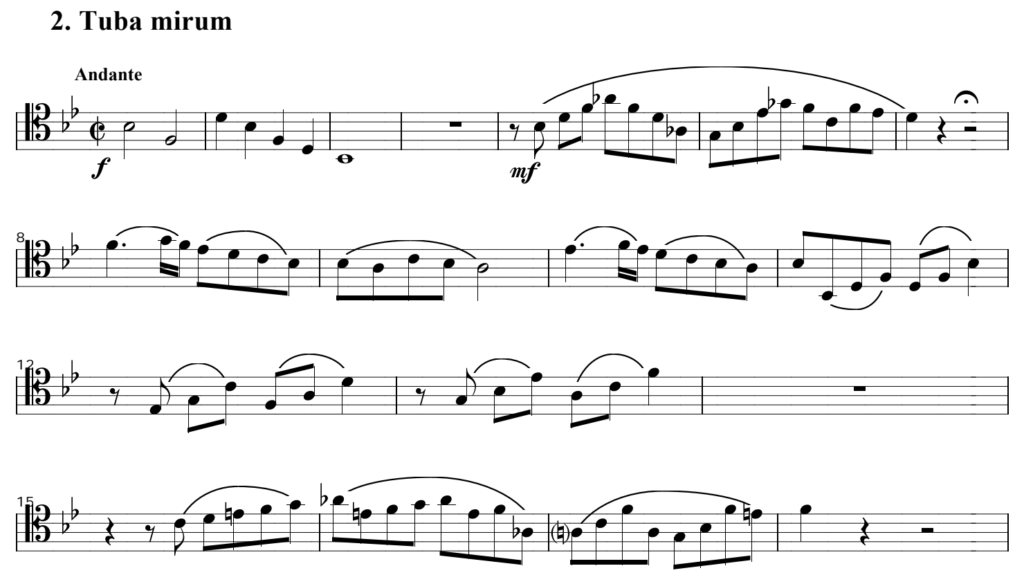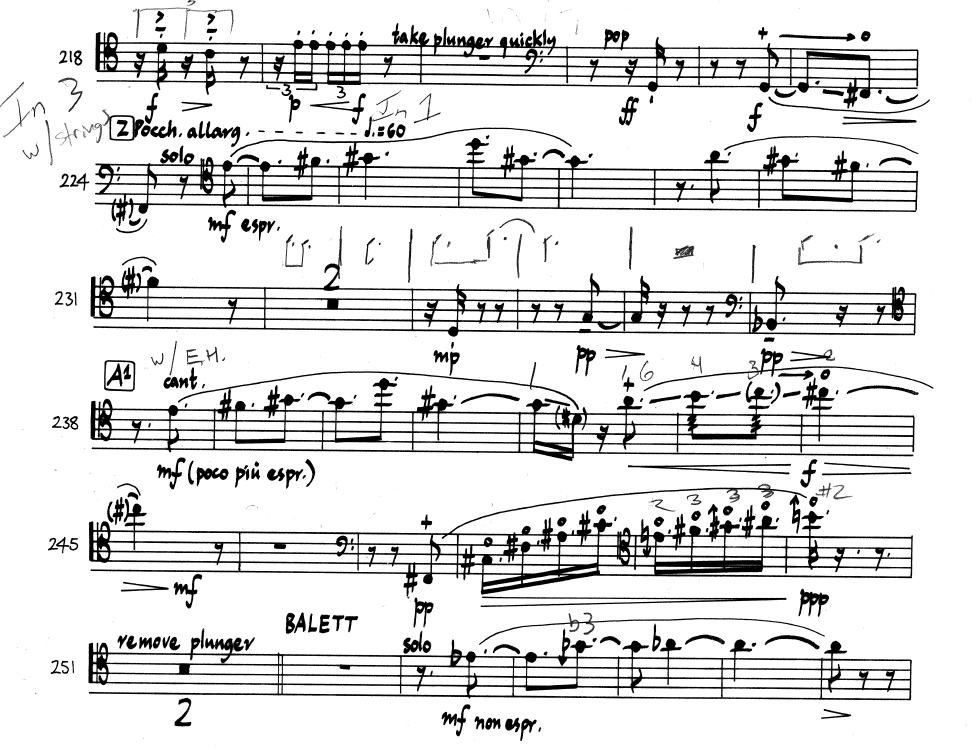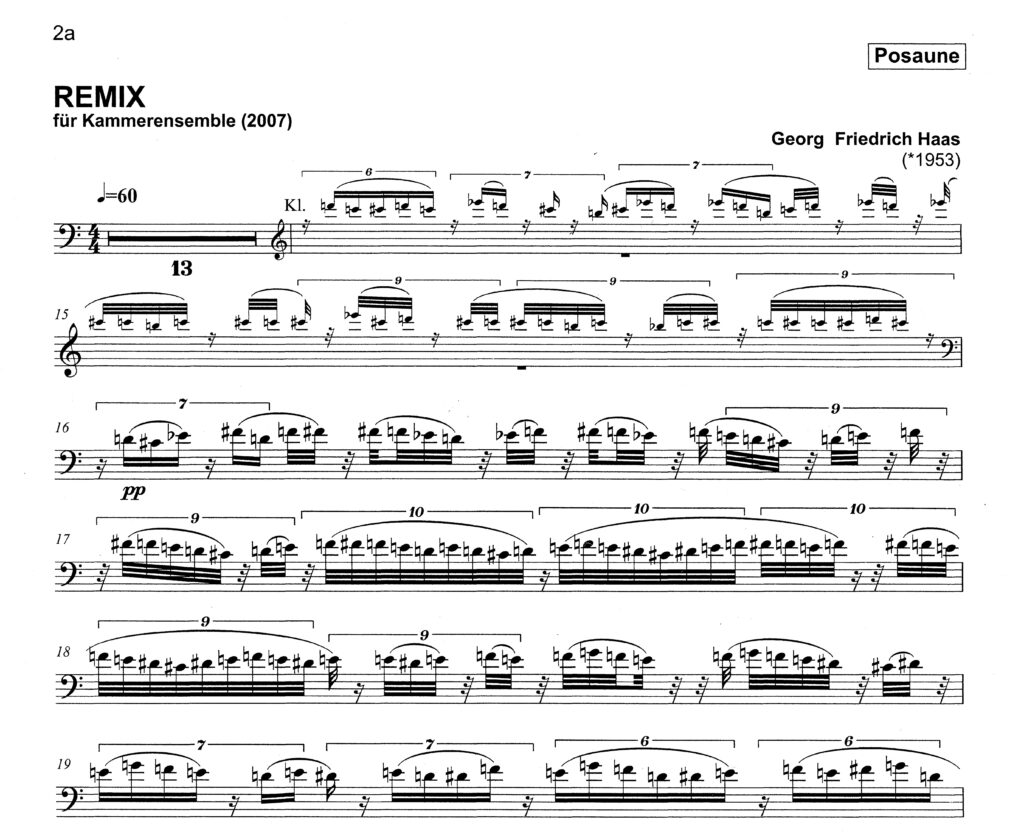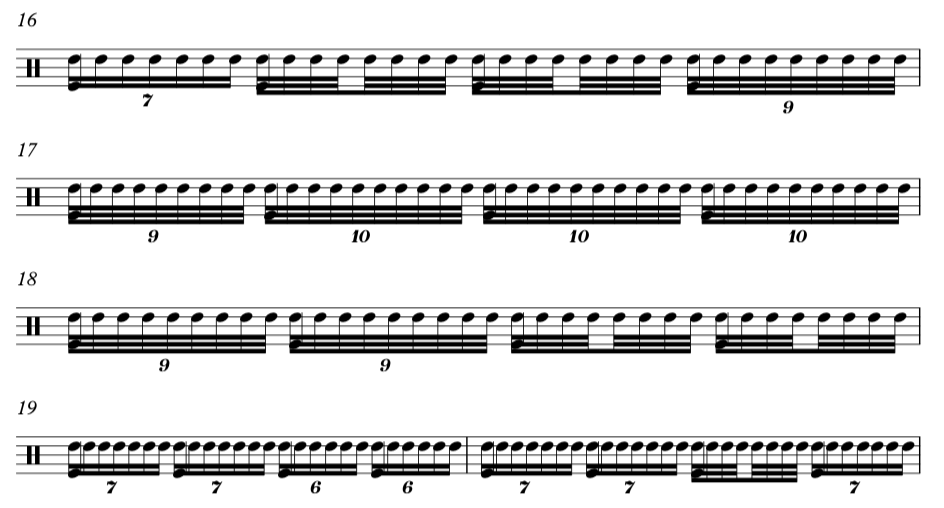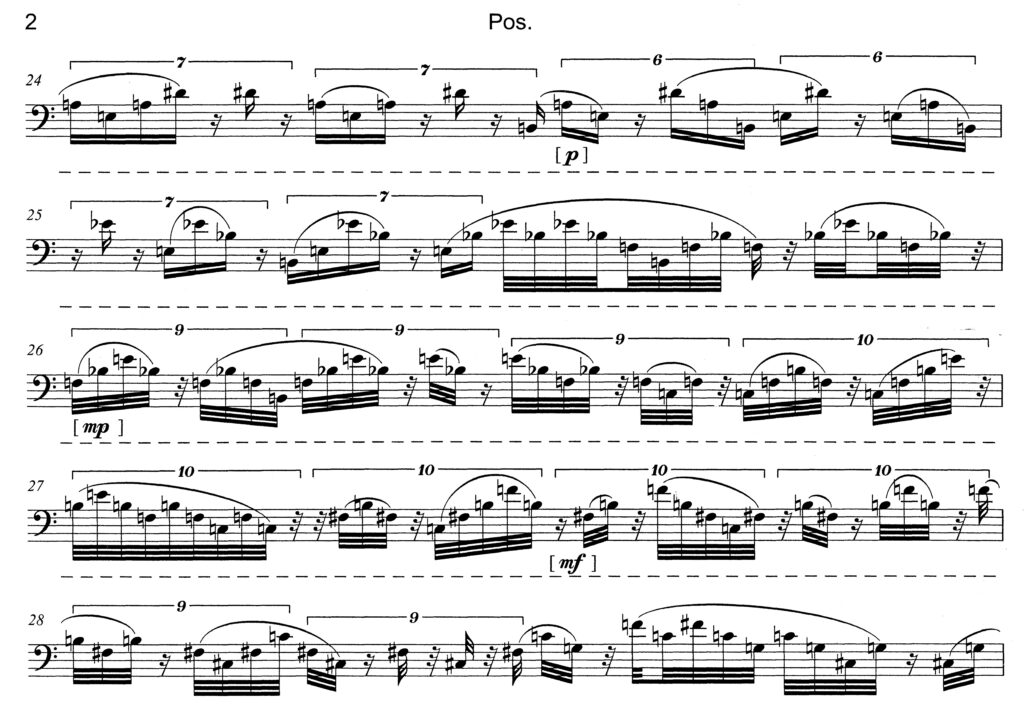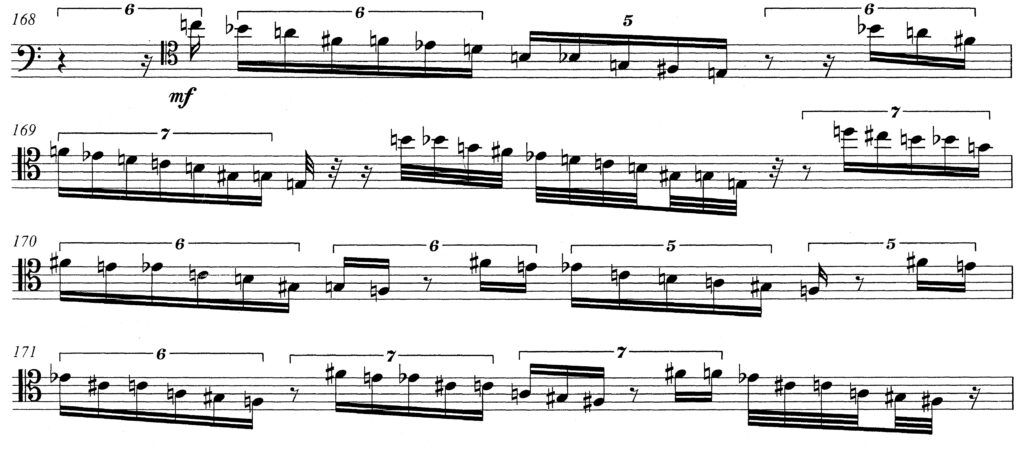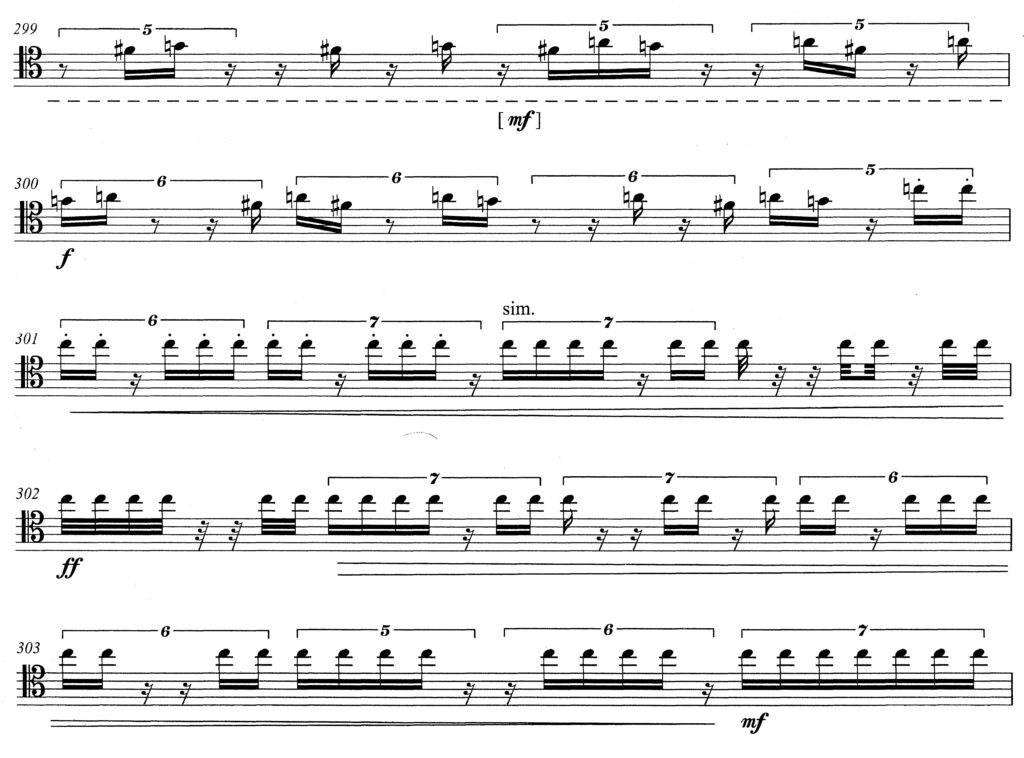| Ablinger, Peter | Weiss / Weisslich 17j | 2014 | 3:07 | trombone, tape | [Details] [Sheet Music] |
| Ablinger, Peter | Music 4 Turtles | 2011 | 5'00" | trumpet, horn, trombone, tuba | [Details] [Sheet Music] |
| Ablinger, Peter | Für Johann Michael Fischer | 1995-6 | 20'00" | 2 trombones, 2 cellos, electronics | [Details] [Recording] |
| Ablinger, Peter | La Fleur de Terezín / Monolith I und II | 1991 | 18'00" | trombone, 12 tape players | [Details] [Recording] |
| Albam, Manny | Escapade | 1972 | | bass trombone, woodwind quintet (flute, oboe, clarinet, bassoon, horn) | [Sheet Music] |
| Anderson, T.J. | Minstrel Man | 1977 | 10'00" | bass trombone, percussion | [Sheet Music] [Recording] |
| Avitsur, Eitan | Poema sonoris No. 2 | 2001 | 20'00" | clarinet, trombone, electronics | [Sheet Music] |
| Avitsur, Eitan | Trio | 1991 | 12'00" | trumpet, trombone, percussion | [Sheet Music] |
| Avrahami, Gad | Sextet No. 1 | 1996 | 11'00" | horn, trombone, two percussionists, harp, amplified double-bass | [Sheet Music] |
| Aitken, Robert | Kebyar | 1971 | 19'00" | flute (doubling woodblock), clarinet (doubling woodblock), percussion, trombone, 2 double bass, tape | [Sheet Music] [Recording] |
| Albert, Thomas | Sound Frames | 1970 | 6'00" | oboe, alto saxophone, trombone, vibraphone | [Sheet Music] |
| Albright, William | Sweet Sixteenths | 1980 | 4'30" | clarinet, trombone, cello, piano | |
| Alvarez, Javier | Bone Ki Gaku | 1984 | 12'00" | trombone, marimba | |
| Alvarez, Javier | Mambo Vinko | 1993 | 15'00" | trombone, electronics | |
| Ammann, Benno | Inventum | 1972 | 19'19" | trombone, piano, tape or 2 trombones, 2 pianos | |
| Amy, Gilbert | Cuivres | 1962 | 5'00" | 2 trumpets, trombone | |
| Amy, Gilbert | Le Temps du souffle II | 1994 | 15'00" | saxophone, trombone, violin | |
| Anderson, Barry | Tucket Sound the sonance and the note to mount | 1983 | 10'30" | trombone, tape | [Recording] [Video] |
| Andre, Mark | Pièces Noire | 1992 | 10'00" | harp, trombone, bass clarinet and cello | |
| Andre, Mark | Le Loin et le Profond | 1994-5 | | bass clarinet, trombone, viola, cello, double bass, prepared piano, percussion | |
| Andrix, George | Free Forms | 1974 | 8'30" | bass trombone, 2 violins, viola, cello, double bass | [Sheet Music] |
| Antheil, George | Symphony for Five Instruments (revised) | 1923 | 13'00" | flute, bassoon, trumpet, trombone, viola | [Recording] [Video] |
| Appert, Donald | Dialogue | 1978 | 5'00" | trombone, viola or cello | |
| Appert, Donald | Sehnsucht | 1981 | 8'00" | trombone, harp (or piano) | |
| Applebaum, Mark | Sum=Parts: IV. Depth | 2004 | 4'00" | trombone, bass | [Recording] |
| Applebaum, Mark | The Composer's Middle Period | | 3'00" | oboe, bass clarinet, trumpet, trombone, violin, cello | [Recording] |
| Ator, James | Seesaw | 1981 | 2'30" | bass trombone, percussion | [Sheet Music] |
| Axelsson, Jonny | Dream Weaving - Annoyance | | | trombone, percussion | |
| Azevedo, Sergio | Chipping Norton, 8 November 1950: A Birthday Card for Christopher Bochmann | | | flute, clarinet, horn, trombone | |
| Baboni-Schilingi, Jacopo | Intermezzi | 2003 | | baritone saxophone, trombone, tuba, electronics | [Details] [Sheet Music] |
| Bachelder, Daniel | Piece for Trombonist and Percussionist | 1974 | 4'15" | trombone, percussion | |
| Balada, Leonardo | Cuatris | 1970 | 8'30" | flute (or violin), clarinet (or viola), trombone (or cello or bassoon), prepared piano (or harpsichord) | [Recording] |
| Baley, Virko | Partita | 1976 | | trombone, piano, tape | |
| Balissat, Jean | 7 Péchés capitaux | 1994 | 12'00" | clarinet, bassoon, trumpet, trombone, violin, double bass, percussion | [Sheet Music] [Details] [Recording] |
| Baltakas, Vynkintas | Pusline | 1997-2000 | 6'00" | flute, oboe, clarinet (E flat), 2 violins, double bass, trombone, tuba, piano, percussion | [Details] [Recording] [Sheet Music] |
| Baltakas, Vynkintas | Redditio | 2010 | 10'00" | flute, clarinet, horn, trumpet, trombone (alto), percussion, 2 violin, viola, cello | [Details] [Recording] [Sheet Music] |
| Balter, Marcos | On Floating Bodies | 2012 | | flute, oboe, clarinet, bassoon, horn, trumpet, trombone, tuba | [Details] |
| Banchieri, Adriano | Sonata sopra l'aria del Gran Duca | 1620 | | trombone, 2 violins, continuo | [Recording] |
| Banchieri, Adriano | Three Sonatas, Op. 43 | 1622 | | trombone, violin, continuo | |
| Bankert, Robert | Duo | 1973 | | bass trombone, marimba | |
| Bardanashvili, Josef | The Yellow Blues | 2001 | 9'00" | flute, oboe, clarinet, bassoon, horn, trumpet, trombone, percussion, violin, viola, double bass | [Score] |
| Bargielski, Zbigniew | Ein Zimmer | 1973 | | trombone, clarinet, cello, piano, reciter (tape) | |
| Barrett, Richard | Earth | 1987-88 | 11'30" | trombone, percussion | [Sheet Music] [Recording] [Video] |
| Barrett, Richard | Aurora | 2005-10 | 7'30" | alto trombone, flugelhorn | [Video] |
| Barrett, Richard | basalt-E | 1992 | 8'00" | trombone, violin, viola, cello, bass | [Details] [Sheet Music] [Recording] |
| Barros, Bernardo | Catstrophe | 2012 | 10'00" | bass clarinet, tenor/bass trombone, cello, piano
| [Details] [Sheet Music] |
| Bartlett, Martin | États | 1987 | 17'45" | trombone, electronics | [Recording] |
| Bartling, Stefan | IJOB | 2006 | 12'22" | horn, trombone, tuba, electronics | [Sheet Music] |
| Bartling, Stefan | Patt | 1998 | 7'45" | clarinet, trombone, cello, piano | |
| Bartling, Stefan | Material | 1996 | 3'28" | bass clarinet, trombone, percussion, viola, cello, piano | |
| Baschet, Florence | Trinacria | 2010 | 10'00" | viola, trombone, guitar | [Details] [Sheet Music] [Recording] |
| Bayolo, Armando | The Book of Bokonon | 2012 | 30'00" | clarinet, trumpet, trombone, percussion, violin, double bass, optional soprano or singing violinist | [Details] [Sheet Music] |
| Bazelon, Irwin | Triple Play | | 12'00" | trombone, bass trombone, percussion | [Sheet Music] [Recording] |
| Bédard, Daniel | STUDy, STUdy, STudy, Study | 1994 | | trombone, live electronics | |
| Bédard, Daniel | Looking Back | 2000 | | sackbut, tenor saxophone, piano, tape | |
| Behrend, Fritz | Kleine Kakteensammlung | 1951 | | trombone, violin, double bass | |
| Bell, David | Corposant | | | flute, trombone | |
| Belli, Giulio | Canzona | 1613 | | trombone, 2 violins, continuo | [Video] |
| Benson, Warren | Largo Tah | 1978 | 12'00" | bass trombone, marimba | [Sheet Music] |
| Berger, Jonathan | Haiku | 2001?/2002? | | trombone, electronics | [Details] |
| Bergsma, William | Blatant Hypotheses | 1977 | 8'00" | trombone, percussion | |
| Bergsma, William | Four All | 1979 | | clarinet, trombone, percussion, cello | [Sheet Music] |
| Bernardi, Steffano | Canzoni à tre, Op. 12 | 1621 | | trombone, 2 violins, continuo | [Sheet Music] |
| Bertali, Antonio | Sonata à 3 No. 1 in D Minor | 1662 or before | | trombone, 2 violins, organ, continuo | [Recording] |
| Bertali, Antonio | Sonata à 3 No. 2 in D Minor | 1662 or before | | trombone, 2 violins, organ, continuo | [Recording] |
| Bertali, Antonio | Sonata à 3 No. 3 in A Minor | 1662 or before | 6'16" | trombone, 2 violins, continuo | [Video] |
| Bialosky, Marshall | Six Riddles from Symphosius | 1976 | 3'30" | voice, cello, trombone | |
| Bialosky, Marshall | Two Songs | 1977 | 8'00" | soprano, bass trombone | |
| Biber, Franz Ignaz | Sonata à 3 | 17th century | 7'00" | trombone, 2 violins, continuo | [Sheet Music] |
| Bird, David | how to build a_bomb | 2014 | | 8 singers, string quartet, bass clarinet, trombone | |
| Blacher, Boris | Five Negro Spirituals | 1962 | 13'00" | soprano, 3 clarinets, trombone, timpani, percussion, double bass | [Sheet Music] |
| Blacher, Boris | Divertimento | 1946 | 10'00" | trumpet, trombone, piano | [Sheet Music] [Video] |
| Blass, Noa | Had gadya | 2001 | 8'00" | clarinet, piano, trombone, bassoon, percussion (timpani), narrator | [Sheet Music] |
| Blickhan, Tim | Quintet | 1975 | 4'00" | alto flute, trombone, viola, percussion, piano | [Sheet Music] |
| Bois, Rob du | Musique d'atelier | 1968 | | clarinet, trombone, cello, piano | |
| Bolter, Norman | Temptation | 1998 | | bass trombone (or serpent), string quartet (2 violins, viola, cello) | [Sheet Music] |
| Bozza, Eugène | Trois Essais | 1977 | 14'00" | trombone, percussion | [Sheet Music] |
| Braga, Antonio Francisco | Dialogo sonoro ao lunar | 1946 | 3'30" | alto saxophone, trombone | [Video] |
| Brandon, Sy | Random 7 | 1975 | 9'00" | trombone, percussion | |
| Brandon, Sy | Neverland | 2012 | 20'00" | flute, trombone, narrator (optional) | [Sheet Music] |
| Brandon, Sy | Sonatina | 1970 | 9'00" | oboe, trombone (bassoon or euphonium) | [Sheet Music] |
| Brandon, Sy | Interplay | 2011 | 14'00" | trombone (or bassoon or euphonium), tuba (or bass clarinet), piano | [Sheet Music] |
| Brandon, Sy | Three Celtic Settings | 1996 | 7'00" | oboe, trombone (or euphonium), viola | [Sheet Music] |
| Brandon, Sy | Chaconne and Variations | 1969 | 7'00" | oboe, alto saxophone, 2 french horns, trombone, piano | [Sheet Music] |
| Brass, Nikolaus | Nachtmusik | 1981 | 13'30" | clarinet, trombone, violin, viola, cello, 3 percussion | |
| Brass, Nikolaus | Salut/Adieu | 1994/2008 | 9'00" | tumpet, trombone | |
| Brass, Nikolaus | Salut II | 2009 | 6'00" | trumpet, trombone | |
| Braunlich, Helmut | Duo for Violin/Viola and Trombone (Tenor/Alto) and Tape | 1977 | 12'00" | tenor/alto trombone, violin or(?) viola, tape | |
| Brettingham Smith, Jolyon | O Rise, Op. 6 | 1973 | 10'00" | flute (piccolo, C flute, alto flute, bass flute), trombone, harpsichord, piano, 2 percussion, cello | [Sheet Music] |
| Brings, Allen | Burlette | 1973 | 6'15" | flute, clarinet in A, trombone | [Sheet Music] |
| Brown, Anthony | Additions | 1973 | 5'00" | amplified flute, trombone, tape delay, slides | [Sheet Music] |
| Brown, Earle | Times Five | 1972 | 15'00" | flute, trombone, harp, violin, cello, tape | [Sheet Music] |
| Brown, Newel Kay | Hopkins Set | 1978 | 6'19" | baritone voice, trombone | [Sheet Music] |
| Bruce, Neely | Untitled Piece No. IV | 1969 | 5'00" | trombone, percussion | [Sheet Music] |
| Burtner, Matthew | Aes/Aer | 2005 | 12'00" | trombone, electronics | [Details] [Sheet Music] |
| Buss, Howard | Capriccio | 1986 | 13'00" | clarinet, trombone, percussion | [Details] [Sheet Music] [Recording] |
| Buss, Howard | Dream Sequence | 1987 | 10'00" | trombone, 4 percussion | [Details] [Sheet Music] [Recording] |
| Buss, Howard | Florida Tableau | 1987 | 16'40" | clarinet, trombone, piano | [Details] [Sheet Music] [Recording] |
| Buss, Howard | Night Tide | 1995 | 8'30" | trombone, marimba | [Details] [Sheet Music] [Recording] |
| Buss, Howard | Boom Time | 1998 | 12'00" | trombone, percussion | [Details] [Sheet Music] [Recording] |
| Buss, Howard | Contrasts in Blue | 2001 | 15'30" | trumpet, trombone, piano | [Details] [Sheet Music] [Recording] |
| Buss, Howard | Fables from Aesop | 2001 | 13'00" | trombone, violin | [Details] [Sheet Music] [Recording] [Video] |
| Buss, Howard | Time Capsule | 2002 | 7'00" | trumpet, trombone | [Details] [Sheet Music] [Recording] |
| Buss, Howard | Diversions | 2009 | 13'00" | flute, trombone | [Sheet Music] [Video] |
| Buss, Howard | Zoom | 2011 | 10'30" | bass trombone, harp | [Details] [Sheet Music] [Recording] |
| Buss, Howard | Imaginations | 2012 | 14'00" | horn, trombone, piano | [Details] [Sheet Music] [Recording] |
| Buss, Howard | Alien Loop De Loops | 2015 | 6'47" | trombone or bass trombone, electronics (tape) | [Details] [Sheet Music] [Recording] |
| Cacciatore, Maurilio | Flone | 2009-10 | 5'40" | flute, trombone | |
| Cage, John | Five3 | 1991 | 40'00" | trombone, string quartet (2 violins, viola, cello) | [Details] [Recording] |
| Calissi, Jeff | Music & Motion | 2006 | | marimba, trombone | [Sheet Music] [Details] [Recording] |
| Campo, Frank | Commedie, Op. 42 | 1971 | 5'00" | trombone, percussion | [Recording] [Sheet Music] |
| Campo, Régis | Les Villes-lumières | 1994 | 6'00" | trumpet, horn, trombone | [Sheet Music] |
| Carter, Elliot | Luimen | 1997 | 12'00" | trumpet, trombone, harp, vibraphone, mandolin, guitar | [Details] [Sheet Music] [Recording] [Video] |
| Cascone, Kim | Sonus Aurea | 2010 | | trombone, electronics | |
| Cazzati, Maurizo | Sonata della la Vecchia | | 5'00" | trombone, 3 violin, viola, cello, organ | |
| Cerha, Friedrich | Quintet | 2004-5 | 24'00" | trombone, string quartet (2 violins, viola, cello) | |
| Cervetti, Sergio | Raga I | 1971 | indeterminate | trombone, graphic notation (open ensemble) | |
| Cervetti, Sergio | Raga II | 1971 | indeterminate | trombone, graphic notation (open ensemble) | |
| Cervetti, Sergio | Raga III | 1972 | indeterminate | trombone, graphic notation (open ensemble) | |
| Cervetti, Sergio | Melodies | 1972 | | trombone, tape delay | |
| Cervetti, Sergio | Madrigal | 1975 | | soprano, 2 clarinets, trombone | |
| Cervetti, Sergio | Madrigal IV | 1984 | | soprano, flute, C trumpet, tenor trombone, violoncello, double bass | |
| Cerrone, Christopher | Recovering | 2012 | 9'00" | clarinet, bassoon, trumpet, trombone, percussion, violin, double bass | [Details] [Video] [Recording] [Sheet Music] |
| Chan, Ka Nin | Prairie | 1977 | 6'00" | trombone, tape | [Sheet Music] |
| Chao, Ching-Wen | The Captured Shadow | 2001 | | soprano trombone, delay, pre-recorded tape | |
| Chardon, Yves | Concerto for Trombone and Chamber Orchestra of Percussion Instruments, Op. 35 | 1974 | 15'00" | trombone, celeste, vibraphone, xylophone, timpani, 3 percussion | |
| Chen, Carolyn | Oceans in Oceans | 2014 | 12’00” | flute, clarinet, bassoon, french horn, trombone, 2 percussion, piano, violin, viola, cello, double bass | [Recording] |
| Chen, Carolyn | We are small and wee and we eat the house down | 2011 | 9’00” | trombone, string quartet (2 violins, viola, cello) | |
| Chepil Reid, Darlene | Jehome and Haalsan | 2000 | 12'20" | trombone, tape | [Details] |
| Chun-Ting, Pang | Vocalize the Voicelessness | 2014 | 9'00" | trombone, percussion, piano, cello | [Recording] [Sheet Music] |
| Ciobanu, Maia | Silence with Variations | 2000 | 15'00" | clarinet, trombone, violin, cello, piano, percussion | |
| Ciobanu, Maia | Ostinato II | 1995 | 9'00" | clarinet, trombone, percussion, piano | |
| Ciobanu, Maia | Preludio for Clarinet, Guitar, and Trombone | 1981 | 8'00" | clarinet, guitar, trombone | |
| Clementi, Aldo | Berceuse 3 | 2001 | | twelve woodwinds, trombone | [Sheet Music] |
| Cohen, Gerald | Preludes and Debka | 2001 | 13'00" | trombone, string quartet (2 violins, viola, cello) | [Recording] |
| Cole, Elliot | Roman de la Rose (on Stockhausen: Cancer) | 2012 | 4'00" | clarinet, bassoon, trumpet, trombone, percussion, violin, double bass, optional soprano (or singing violinist) | [Video] |
| Colombo-Taccani, Giorgio | Kyrie | 1998 | 11'00" | trombone, tape, live electronics | [Recording] [Details] |
| Coolidge, Richard | Illuminations | 1980 | 9'00" | bass trombone, vibraphone | |
| Conynham, Barry | Voicings | 1983 | 14'00" | flute, trombone, percussion, piano, tape | |
| Cori, Luca | Ypnos | 1990 | 13'00" | flute, oboe, english horn, clarinet, bassoon, french horn, trumpet, trombone, piano | [Details] |
| Croson, James | We Interrupt This Breaking News | 2012 | 6'20" | trombone, electronics | [Details] [Sheet Music] [Recording] |
| Croson, James | The On-again, Off-again Long Distance Pony | 2011 | 4'10" | trombone, electronics | [Details] [Sheet Music] [Recording] |
| Croson, James | Internal Rhyme | 2011 | 4'30" | trombone, electronics | [Details] [Sheet Music] [Recording] |
| Cuckson, Robert | Eshel Yehuda | 2001 | | trombone, tape | |
| Cuckson, Robert | Quintet for Trombone and String Quartet | 2000 | | trombone, string quartet (2 violins, viola, cello) | |
| Dalkert, Charles | A Muse Meant | 1970 | | trombone, percussion | |
| Dallin, Leon | Divertimento | 1956 | 12'00" | clarinet in A or viola, trombone (or cello or bassoon), violin, piano | |
| Davison, John | Quintet | 1970 | 15'00" | trombone, string quartet (2 violins, viola, cello) | [Video] |
| Deason, David | Sonata | 1981 | 9'00" | alto saxophone, trombone (or euphonium), piano | |
| Dedrick, Christopher | Inspiration | 1970 | | clarinet, 2 trumpet/flugelhorn, bass trombone, cello | |
| Dedrick, Christopher | Sonata | 1972 | 5'40" | bass trombone, piano, 2 percussion | |
| Della Peruti, Carl | Autumn Music | 1972 | 4'00" | flute, clarinet, trombone, piano | |
| Della Peruti, Carl | Diversion | 1972 | 6'10" | trombone, percussion | |
| Della Peruti, Carl | Endgame | 1974 | 8'30" | 2 clarinets, trombone, cello, piano | |
| Della Peruti, Carl | Leftovers | 1973 | 5'45" | clarinet, bass clarinet, trombone, piano | |
| Del Mónaco, Alfredo | Dualismos | 1971 | 8'00" | flute, clarinet, trombone, piano, tape | |
| Delp, Ron and Weiss, Edgar | Modogenesis | 1972 | 8'00" (also found a citation for 18'00") | trombone, percussion | |
| De Pablo, Luis | Pardon | 1972 | 2'00" | trombone, clarinet | [Sheet Music] |
| Denisov, Edison | DSCH | 1969 | 5'00" | clarinet, trombone, piano, cello | [Sheet Music] [Video] |
| Deterling, Ian | Duet for Bass Trombone and Viola in f minor | | 16'00" | bass trombone, viola | [Video] |
| Dicke, Ian | Latest and Greatest | 2015 | 15'00" | flute, trombone, percussion (vibraphone), piano, violin, electronics | [Details] |
| Dicke, Ian | Musa | 2010 | 8'15" | trombone, violin, live electronics | [Sheet Music] [Details] [Recording] [Video] |
| Dion, Denis | En second lieu | 1992 | 10'33" | trombone, live electronics | [Details] |
| Dompierre, François | Jardin d'hiver | 1989 | 10'40" | trombone, tape | |
| Douglas, Robert | La sphere frissonnante | 1988 | 10'00" | trombone, electronics | [Sheet Music] |
| Druckman, Jacob | Animus I | 1966 | 13'00" | trombone, electronics | [Sheet Music] |
| Duncan, Eve | Below the Star-Streched Sky | 2006 | 6'00" | bass trombone, string quartet (2 violins, viola, cello) | [Details] |
| Durupt, Laurent | Ubiitsi | 2007 | | percussion, trumpet, trombone, live electronics | [Details] [Recording] [Video] |
| Dusapin, Pascal | Neuf Musiques pour "Le Fusil de chasse" | 1989 | 12'00" | clarinet, trombone, cello | |
| Dzierlatka, Arié | Dedans - Dehors | 1973 | | 2 percussion, french horn, trombone, piano | [Sheet Music] |
| Ehrlich, Abel | Ensemble | 2001 | 10'00" | oboe, clarinet, horn, saxophone, trumpet, trombone, percussion, violin, viola | [Sheet Music] |
| Ehrlich, Abel | The Flute Player..., for six players | 2001 | 4'00" | flute?, trombone?, ? | [Sheet Music] |
| Ehrlich, Abel | Three Dreams | 2001 | 9'00" | oboe, alto saxophone, bassoon, trumpet, trombone, percussion, violin, viola, cello | [Sheet Music] |
| Ehrlich, Abel | Three Movements | 2001 | 7'00" | flute, trombone, guitar, cello | [Sheet Music] |
| Ehrlich, Abel | Makes the Abyss Boil | 2000 | 11'00" | horn, trumpet, trombone, violin | [Sheet Music] |
| Ehrlich, Abel | Wiped-Out | 2000 | 5'00" | mixed choir, trombone | [Sheet Music] |
| Ehrlich, Abel | Urban | 1999 | 1'00" | voice (baritone), trombone | [Sheet Music] |
| Ehrlich, Abel | And Did Not Know That There Were Ghosts | 1998 | 5'00" | trumpet, trombone, tuba | [Sheet Music] |
| Ehrlich, Abel | Bridge | 1998 | 6'00" | soprano voice, viola, trombone | [Sheet Music] |
| Ehrlich, Abel | Choirs for Instruments II | 1998 | 8'00" | trumpet, trombone, piano, viola, cello | [Sheet Music] |
| Ehrlich, Abel | Choirs for Instruments IV - "Sophocles" | 1998 | 8'00" | oboe, horn, trombone, violin, viola, double bass | [Sheet Music] |
| Ehrlich, Abel | Conversation | 1998 | 5'00" | soprano voice, flute, trombone, violin, cello | [Sheet Music] |
| Ehrlich, Abel | From the Embassy | 1998 | 5'00" | flute, oboe, clarinet, trumpet, trombone, cello | [Sheet Music] |
| Ehrlich, Abel | May 1998 | 1998 | 11'00" | flute, trombone, viola, cello | [Sheet Music] |
| Ehrlich, Abel | Problems of Mankind | 1998 | 17'00" | flute, oboe, clarinet, bassoon, horn, trombone, violin, 3 violas, cello | [Sheet Music] |
| Ehrlich, Abel | Conducting | 1997 | 4'00" | baritone? voice, tenor saxophone, trumpet, trombone, piano | [Sheet Music] |
| Ehrlich, Abel | Ein Strenger Satz | 1997 | 4'00" | flute, oboe, clarinet, bassoon, horn, trumpet, trombone, cello | [Sheet Music] |
| Ehrlich, Abel | Night-Asylum | 1997 | 13'00" | flute, oboe, clarinet, bassoon, trumpet, trombone, violin, viola, cello, double bass | [Sheet Music] |
| Ehrlich, Abel | Septet | 1997 | 15'00" | flute (doubling piccolo), bassoon, horn, trumpet, trombone, viola, double bass | [Sheet Music] |
| Ehrlich, Abel | Speech of the Mourner for His Friend | 1997 | 1'00" | voice (mezzo soprano, alto, or baritone), trumpet, trombone | [Sheet Music] |
| Ehrlich, Abel | The Hawk | 1997 | 3'00" | voice (tenor), trombone, viola | [Sheet Music] |
| Ehrlich, Abel | The Honest Poet | 1997 | 3'00" | voice (tenor), horn, trumpet, trombone | [Sheet Music] |
| Ehrlich, Abel | The Light Shines Even More... | 1997 | 8'00" | flute, oboe, violin, viola, trombone, double bass | [Sheet Music] |
| Ehrlich, Abel | You Are Walking Within the Clocks of Old Streets | 1997 | 4'00" | flute, oboe, clarinet, bassoon, trombone, piano, 2 violins, viola, cello, double bass | [Sheet Music] |
| Ehrlich, Abel | Forms of the Rock in a Night-Hymn | 1996 | 12'00" | clarinet, bassoon, 2 trumpets, horn, trombone, tuba | [Sheet Music] |
| Ehrlich, Abel | "You don't See Me, Actually I'm Not Here", She Said | 1996 | 5'00" | flute, oboe, clarinet, trumpet, horn, trombone | [Sheet Music] |
| Ehrlich, Abel | In Memory of David Vogel | 1996 | 7'00" | oboe, bass clarinet, bassoon, trumpet, trombone, violin, viola, cello | [Sheet Music] |
| Ehrlich, Abel | Junction - Point of Network | 1996 | 7'00" | flute, trombone, 2 percussion, double bass | [Sheet Music] |
| Ehrlich, Abel | Leggero | 1996 | 4'00" | flute, trombone, violin, cello | [Sheet Music] |
| Ehrlich, Abel | Paul Celan | 1996 | 14'00" | flute, clarinet, trombone, guitar, harp, 2 violins, viola, cello | [Sheet Music] |
| Ehrlich, Abel | Strange Traits of Men: Fun After Funeral | 1996 | 3'00" | flute, oboe, clarinet, bassoon, trumpet, trombone | [Sheet Music] |
| Ehrlich, Abel | Two Poems After Ibn Gabirol | 1996 | 15'00" | voice (soprano), clarinet, guitar, harp, viola, cello, trombone | [Sheet Music] |
| Ehrlich, Abel | Disillusionment of Ten O'Clock | 1995 | 9'00" | tenor voice?, flute, oboe, clarinet, trumpet, trombone, celesta, vibraphone, percussion, guitar, violin, double bass | [Sheet Music] |
| Ehrlich, Abel | Music for 8 Performers | 1995 | 10'00" | flute, alto saxophone, trumpet, trombone, percussion, piano, violin | [Sheet Music] |
| Ehrlich, Abel | Rembrandt: Five Drawings | 1993 | 10'00" | flute, oboe, clarinet, bassoon, trumpet, trombone, violin, viola, cello | [Sheet Music] |
| Ehrlich, Abel | Such Seemings | 1993 | 8'00" | oboe, alto saxophone, horn, trumpet, trombone, viola, cello | [Sheet Music] |
| Ehrlich, Abel | Suspenso gradu | 1993 | 6'00" | flute, bass clarinet, horn, trombone, percussion, violin, double bass | [Sheet Music] |
| Ehrlich, Abel | The Crowd and the Quarrel | 1993 | 4'00" | oboe, clarinet, trumpet, trombone, violin, cello | [Sheet Music] |
| Ehrlich, Abel | The Desert is Eternal | 1993 | 7'00" | trumpet, horn, trombone, double bass | [Sheet Music] |
| Ehrlich, Abel | Concert in April | 1991 | 10'00" | flute, clarinet, bassoon, trombone, violin, cello, double bass | [Sheet Music] |
| Ehrlich, Abel | Bitter Bond | 1991 | 7'00" | horn, trombone, double bass | [Sheet Music] |
| Ehrlich, Abel | Gilgul | 1990 | 2'00" | tenor voice, trombone | [Sheet Music] |
| Ehrlich, Abel | Little Concerto for 7 Players | 1990 | 7'00" | flute, bassoon, horn, trombone, percussion, viola, cello | [Sheet Music] |
| Ehrlich, Abel | Mental Cure | 1990 | 10'00" | flute, bass clarinet, trumpet, trombone, percussion, piano, violin, double bass | [Sheet Music] |
| Ehrlich, Abel | A Letter from November 24, 1810 | 1987 | 7'00" | flute, trombone, percussion, piano, violin, double bass | [Details] [Sheet Music] |
| Ehrlich, Abel | Nonet 1987 | 1987 | 8'00" | clarinet, bassoon, horn, trumpet, trombone, percussion, piano, viola, double bass | [Sheet Music] |
| Ehrlich, Abel | Six | 1987 | 11'00" | clarinet, horn, trombone, viola, cello, double bass | [Sheet Music] |
| Ehrlich, Abel | The Song of Avshay | 1985 | 5'00" | voice (baritone), bassoon, trombone | [Sheet Music] |
| Ehrlich, Abel | Ich bin auf dem Weg | 1984 | 2'00" | voice (baritone), oboe, clarinet, trombone, piano, viola, cello, double bass | [Sheet Music] |
| Ehrlich, Abel | Ich wohne bei fremden Menschen | 1984 | 4'00" | voice (baritone), oboe, clarinet, trombone, piano, viola, cello, double bass | [Sheet Music] |
| Ehrlich, Abel | Übungen im Träume-Erzählen | 1984 | 16'00" | voice (baritone), oboe, clarinet, trombone, piano, viola, cello, double bass | [Sheet Music] |
| Ehrlich, Abel | Greeting to H.P. | 1982 | 5'00" | trumpet, trombone, viola, cello | [Sheet Music] |
| Einarsson Torfi, Einar | Endemi | 2005 | | trombone, cello, piano | |
| Einarsson Torfi, Einar | Tendencies | 2009 | 10'00" | oboe, bass clarinet, trumpet, trombone, violin, bass | [Recording] |
| Elgar, Edward | Duett | 1887 | 1'30" | trombone, double bass | [Sheet Music] [Video] |
| Elkana, Amos | Hommage à Ligeti | 2007 | 9'00" | flute, oboe, clarinet, bass clarinet, horn, trombone, harpsichord (doubling hammond/harmonium), piano (doubling celesta), 2 violins, viola, cello, double bass | [Sheet Music] [Recording] |
| Eötvös, Peter | Intervalles-Intérieurs | 1981 | 30'00" | clarinet, trombone, violin, cello, tape | [Recording] [Video] |
| Everett, Thomas | Duos for Clarinet and Bass Trombone | 1970 | | clarinet, trombone | [Sheet Music] |
| Fairouz, Mohammed | Three Shakespeare Songs | 2006 | 12'00" | clarinet, bassoon, trumpet, trombone, harp, mezzo soprano, violin, double bass | [Sheet Music] |
| Farhang, Alireza | Neda | 2009 | 10'00" | tenor saxophone, trombone, percussion, piano | [Details] [Sheet Music] |
| Favre, Pascal | Celebration | 2000 | 4'30" | flute, clarinet, alto saxophone, 2 trumpets, trombone, tuba, timpani, percussion | [Details] [Sheet Music] |
| Felder, David | Boxman | 1986 | 15'00" | amplified trombone, electronics | [Sheet Music] [Reviews] [Recording] |
| Finsterer, Mark | Piece for Piano, Violin, and Bass Trombone | 1984 | | bass trombone, piano, violin | [Details] |
| Fox, Christopher | Qui/nt/et | 2014 | 15-20'00" | bass clarinet, trombone, electric guitar, cello, double bass | [Recording] |
| Fox, Christopher | Hidden Consequences | 2010 | 10'30" | horn, trombone, tuba | [Recording] [Details] [Sheet Music] |
| Fox, Christopher | Extended Play | 2009 | 17'00" | flute, clarinet, trombone, piano, percussion, electric guitar, violin, viola, cello, double bass | [Details] |
| Fox, Christopher | Zone (Zeit-Ort-Name) | 2004 | 25'00" | clarinet, trombone, tuba, accordion. electric guitar, violin, viola, cello, double bass, electronics | [Recording] |
| Fox, Christopher | an der Schattengrenze | 2002 | 20'00" | bass flute, bass clarinet, bass trombone, percussion, piano, viola, cello, double bass | [Details] |
| Fox, Christopher | Heliotropes2 | 1986 | 9'00" | trumpet, trombone, harp, vibraphone, double bass | [Details] |
| Fox, Christopher | Etwas Lebhaft | 1983 | 16'00" | flute/alto flute, oboe, clarinet, horn, trumpet, trombone, piano, violin, viola | [Details] |
| Fox, Christopher | Recirculation | 1982 | 12'00" | bass trombone, tape | [Details] |
| Fénelon, Philippe | Orion (Mythologie II) | 1988-89 | 21'00" | clarinet, trombone, viola, harp | [Recording] |
| Francesconi, Luca | Animus | 1995 | 12'00" | trombone, live electronics | [Recording] [Video] |
| Franzson, Davið | The Cartography of Time | 2015 | | any combination of: bass clarinet, trombone, piano, violoncello, live electronics | [Details] |
| Fréchette, Charles-Antoine | Appels | 2003 | 8'30" | trombone, electronics | |
| Freund, Don | Trio for Violin, Trombone and Piano | 1971 | 6'45" | violin, trombone, piano | [Details] [Sheet Music] [Recording] |
| Freund, Stefan | The Devil Dances with Tom Sawyer | | | clarinet, bassoon, trumpet, trombone, percussion, violin, double bass | [Video] |
| Fowler, Bruce | Duo for Horn and Trombone | 1995 | 4'00" | french horn, trombone | [Recording] |
| Fowler, Bruce | Duo for Flute and Trombone | 1995 | 6'30" | flute, trombone | [Recording] |
| Fowler, Bruce | 3mod2=1 | 1995 | 3'00" | flute, trombone, electric bass | [Recording] |
| Fujikura, Dai | K's Ocean | 2005-9 | 9'00" | trombone, electronics | [Sheet Music] [Recording] |
| Fusco, Raphael | Meditation on a Prayer | 2003 | 9'00" | alto trombone, flugelhorn, piano | |
| Gane, Peter | Oz | 2011 | | bass trombone, percussion (e flat tenor drum) | [Sheet Music] |
| Gardella, Federico | …come un’apparenza | 2006 | | trombone, electronics | [Details] |
| Gardella, Federico | Berceuses | 2009 | | mandolin, trombone, piano | [Sheet Music] |
| Gardner, Alexandra | Snapdragon | 2002 | 11'00" | trombone, electronics | [Sheet Music] [Recording] [Recording] |
| Gardner, Evan | Pretty Lies | 2009 | | clarinet, viola, piano, trombone | |
| Gardner, Evan | Urban Remedy | 2001 | | vibraphone, trombone | |
| Gervasoni, Stefano | Eyeing | 1999-2000 | 12'00" | alto flute, clarinet, trombone, violin, viola, cello, bass | [Video] |
| Gervasoni, Stefano | Froward | 2011 | 15'00" | horn, trumpet, trombone, solo percussion, violin, viola, cello | [Details] [Recording] |
| Gervasoni, Stefano | Nube obbediente | 2010-11 | 13'00" | trombone, percussion | [Details] [Sheet Music] |
| Giroudon, James | Les Précipités | 1998 | 3'00" | trumpet, horn, trombone | |
| Giuliano, Giuseppe | Adieu mes amours (in memoriam Bruno Maderna) | 1982 | | oboe, clarinet, bassoon, trumpet, trombone, bass trombone, violin, viola, cello, live electronics | [Sheet Music] |
| Giuliano, Giuseppe | QHLT | 1988 | | voice, flute, trombone, tape, live electronics | [Sheet Music] |
| Giuliano, Giuseppe | Vikrtis | 1979 | | bassoon, trombone | [Sheet Music] |
| Glass, Philip | Diversions | 1960?/67? | | 2 flutes, bass trombone | |
| Globokar, Vinko | Destinées machinales | 2008 | 40'00" | clarinet, trombone (also alphorn), percussion, cello, music machine | |
| Goeb, Roger | Concertino (Quintet) | 1952 | | trombone, string quartet (2 violins, viola, cello) | [Sheet Music] |
| Globokar, Vinko | Prestop II | 1991 | 16'00" | trombone, live electronics | |
| Goldmann, Friedrich | tombeau (in memoriam Iannis Xenakis) | 2001 | | bass clarinet, bassoon, violin, cello, trombone, piano | |
| Goldmann, Friedrich | Augenblick für Stimme | 2000 | | flute, oboe, clarinet, trombone, percussion (drum kit), electric guitar, piano (keyboard), viola, cello | |
| Goldmann, Friedrich | Moment for Voice | 2000 | | voice (mezzo-soprano), flute, oboe, clarinet, trombone, drums, electric guitar, viola, cello | |
| Goldmann, Friedrich | Goethe-radicals | 1999 | | voice (alto), voice (tenor), horn, trombone, viola | |
| Goldmann, Friedrich | Constellations | 1998-1999 | | oboe, English horn, trombone, percussion, piano, viola, cello, double bass | |
| Goldmann, Friedrich | ... Almost froze unrest... III | 1995 | | flute, clarinet, horn, trombone, drums, guitar, piano, string quartet (2 violins, viola, cello), double bass | |
| Goldmann, Friedrich | ... Almost froze unrest... II | 1992 | | flute, clarinet, trombone, percussion, string quartet (2 violins, viola, cello), piano | |
| Goldmann, Friedrich | fragile - Mid | 1990 | | oboe, English horn, trombone, percussion, piano, viola, cello, double bass | |
| Goldmann, Friedrich | Lento Scene | 1990 | | oboe, English horn, trombone, percussion, piano, viola, cello, double bass | |
| Goldmann, Friedrich | Bagatelle for 7 Players | 1988 | | flute, oboe, trombone, percussion, viola, cello, double bass | |
| Goldmann, Friedrich | Arie | 1985 | | voice (soprano), oboe, English horn, trombone, percussion, piano, viola, cello, double bass | |
| Goldmann, Friedrich | So und so | 1972 | | English horn, trombone, double bass | |
| Gomelskaya, Julia | Jab-Jazz | 2008 | 8'00" | trombone, piano, percussion | [Video] |
| Gomelskaya, Julia | The Triumph of Adrenaline | 2001 | 9'00" | trombone, percussion | [Recording] |
| Good, Scott | Wind | 1998 | 6'30" | bass trombone, tape | [Details] |
| Good, Scott | Sorensen Variations | 1999 | 16'30" | trombone, string quartet | [Details] |
| Good, Scott | Rise | 2000 | 3'30" | horn (or alto trombone), tenor trombone, bass trombone | [Details] |
| Good, Scott | ...Blood Which Flowed... | 2000 | 11'15" | flute, alto flute, trombone, viola, piano, harp | [Details] |
| Good, Scott | The Bacchae | 2003 | 65'00" | 3 actors, soprano, violin, viola, cello, clarinet (doubling bass), bass trombone, percussion | [Details] |
| Good, Scott | Shock Therapy Variations | 2008 | 19'00" | trombone, electric guitar, flute, clarinet, bassoon, horn, violin, viola, cello, percussion | [Details] |
| Gordon, Michael | The Low Quartet | 1985 | 8'00" | bass clarinet, bari sax, trombone, contrabass (any four low instruments) | [Details] [Sheet Music] [Recording] [Video] |
| Gòrecki, Henryk | Myzycka IV | 1970 | 9'00" | clarinet, trombone, piano, cello | [Sheet Music] [Recording] |
| Grisey, Gérard | Solo pour Deux | 1981-1982 | 15'30" | clarinet, trombone | [Sheet Music] [] |
| Grisey, Gérard | Périodes | 1974 | 16'00" | flute, clarinet, trombone, violin, viola, cello | [Sheet Music] [Recording] [Video] |
| Grisey, Gérard | Solo pour deux | 1981-82 | 18'00" | clarinet, trombone | [Sheet Music] [Recording] [Video] |
| Gross, Eric | Plectrobone I, op. 273/1 | 2003 | 5'00" | trombone, mandolin | [Sheet Music] [Recording] |
| Guerrero Marìn, Francisco | Hyades | 1994 | | voice, flute, trombone, double bass, electronics | [Sheet Music] |
| Halka, Charles | The Painting Makes Me Want to Run Naked | 2010 | 5'00" | trombone, cello, double bass | [Details] |
| Hancock, Susanna | Xeno | 2013 | 5'00" | alto sax, bassoon, guitar, trombone, percussion | [Recording] |
| Hartley, Walter | Suite for Five Winds | 1951 | 7'00" | flute, oboe, clarinet, alto saxophone, trombone | [Sheet Music] |
| Hartley, Walter | Sonata da Camera | 1950 | | oboe, 2 clarinets, bassoon, trombone (with f attachment) | [Sheet Music] |
| Hayward, Robin | Grave Mountain Diagram | 2008 | 40'00" | horn, trombone, tuba | [Details] |
| Hayward, Robin | Duplex Three | 2006 | 3'00" | horn, trombone, tuba | [Details] [Recording] |
| Hayward, Robin | Hommage | 2005 (rev. 2009) | 7'11" | bass trombone, tuba | [Details] [recording] |
| Hennix, Catherine Christer | For Brass and Electronics | | | trumpet, horn, trombone, tuba | |
| Henze, Hans Werne | Amicizia! | 1976 | 15'00" | clarinet, trombone, percussion, piano, cello | [Sheet Music] |
| Hervé, Jean-Luc | Two Infinities | 1993 | | piccolo, bass trombone | |
| Hidas, Frigyes | 1+5 | 1995 | 13'00" | bass trombone, woodwind quintet (flute, oboe, clarinet, bassoon, horn) | [Sheet Music] [Video] |
| Hillborg, Anders | Hautposaune | 1990 | 3'43" | trombone, electronics | [Details] [Sheet Music] [Recording] |
| Hillborg, Anders | U-TANGIA-NA | 1991 | 5'00" | alto trombone, electronics or organ | [Details] [Sheet Music] [Recording] |
| Hodkinson, Juliana | Play on | 2015 | 10'00" | horn, trombone, tuba, electronics | [Details] |
| Hodkinson, Juliana | Play | 2010 | 3'00 | horn, trombone, tuba, electronics | [Details] |
| Hodkinson, Juliana | Inapparent Air and Aviary | 2004 | 10'00" | piccolo, E flat clarinet, trombone, piano, violin, cello | Details] [Sheet Music] |
| Hoffmann, Richard | Decadanse | 1972 | | clarinet, bass clarinet, trumpet, trombone, violin, bass, percussion | [Sheet Music] |
| Honstein, Robert | Marionette | 2012 | 7'00" | clarinet, bassoon, trumpet, trombone, percussion, violin, double bass | [Details] |
| Huber, Nicolas | Angel Dust | 2007-8 | 15'00" | accordion, trombone | |
| Huber, Nicolas | Konzert für naturmodulierte Soli und Ensemble | 2008 | 20'00" | oboe, clarinet, bassoon, trombone, accordion, piano, cello, bass, electronics, video projector | [Sheet Music] |
| Hurel, Philippe | Stretta | 2009 | 11'00" | 2 trombones, organ | [Sheet Music] |
| Hurst, Derek | La Belle Captive | 2001 | | trombone, electronics | |
| Hutter, Gustav | Bläzerfantasie | | | bass trombone, woodwind quintet (flute, oboe, clarinet, bassoon, horn) | |
| Hutter, Gustav | Poem | | | bass trombone, violin, viola, cello, cor anglais, bassoon | |
| Ivanova, Vera | C-A-G-E for Ensemble | 2013 | 1'00" | oboe, bassoon, trumpet, trombone, percussion (marimba), violin, viola, cello | [Details] |
| Ivanova, Vera | Refrains & Ritornellos | 2004 | 5'10" | oboe, clarinet in E flat (doubling bass flute), bassoon, horn, trumpet, trombone, 2 violins, cello | [Details] |
| Ives, Charles | Prelude on "Eventide" | 1902-9 | 1'00" | trombone (or baritone), 2 violins, organ | |
| Jaffrennou, Pierre-Alain | For Three | 2006 | 12'00" | trombone, cello, percussion, electronics | [Recording] |
| Jodlowski, Pierre | People/Time | 2003 | 25'00" | percussion, clarinet, trombone, piano, violin, cello, electronics | [Sheet Music] [[Recording] [Video] |
| Jones, David P. | Capra Ibex | | 12'00" | trombone, double bass, piano | [Recording] |
| Jones, David P. | Rebirth | 1996 | 8'45" | clarinet, trombone, marimba, double bass | [Details] |
| Jugend, Nurit | MOmix (Anonymous?) | 1998 | 6'00" | flute, oboe, trombone, viola | [Sheet Music] |
| Juillerat, Kevin | Study on phonetics | 2014-2015 | 5'00" | trombone, percussion, piano, cello | [Details] [Sheet Music] |
| Kahn, Frédéric | Emphase-Pathos | 1999 | 9'00" | trumpet, trombone | |
| Kahn, Frédéric |
Le miroir des limbes | 1998 | 15'00" | flute, clarinet, trombone, piano | |
| Kazik, James | Introduction and Allegro | 2005 | 5'00" | bass trombone, woodwind quintet (flute, oboe, clarinet, bassoon, horn) | [Recording] |
| Keane, David | Wervelwind | 1992/1993 | | trombone, tape | [Details] |
| Kefeli, Abraham | Genesis | 1993 | 13'00" | tenor saxophone, trombone, percussion, piano | [Sheet Music] [Recording] |
| Kellaway, Roger | Esque | 1972 | 11'30" | trombone, double bass | [Sheet Music] |
| Kim, Texu | Morning, 6/26/2015 | 2015 | 10'00" | flute, trombone, percussion (vibraphone), piano, violin | |
| Kim, Texu | Shake It!! | 2014 | 8'00" | flute, oboe, clarinet (bass clarinet), trombone, piano, violin, viola, cello | [Details] [Video] |
| Kobayashi, Kyoko | Colors | 2005 | | trombone, electronics | |
| Kokoras, Panayiotis | Metasound | 2003 | 7'00" | flute, trombone, percussion, bass | [Details] [Recording] [Sheet Music] |
| Kos, Bozidar | Three Movements | 1982 | 15'00" | flute, trombone, percussion, piano | [Sheet Music] |
| Kouyoumdjian, Mary | Le Bord de l’Infini [The Edge of Infinity] | 2006 | 5'20" | flute, clarinet, violin, cello, trumpet, trombone, piano, percussion | [Recording] |
| Kraft, Leo | About Time | 2002? | | trombone, percussion | [Sheet Music] |
| Kraft, William | Encounters IV, A Duel for Trombone and Percussion | 1973 | 14'00" | trombone, percussion, optional tape | [Sheet Music] [Video] |
| Krajic, David | 1492.1 | 2010 | | trombone, electronics | |
| Kronlaks, Rolands | Moving Shapes | 1999 | 5'00" | bass trombone, electronics | |
| Krüger, Mattias S. | Dreigestirn | 2011 | 10'00" | baritone saxophone, trombone, piano | [Details] Recording] [Sheet Music] |
| Kudirka, Joseph | how the face veil is worn | | 13'15" | horn, trombone, tuba | [Recording] |
| Kurtàg, György | A kis csáva | 1978 | 7'00" | piccolo, trombone, guitar | [Sheet Music] [Recording] [Video] |
| Lane, Richard | Jigsaw | 1984 | 10'00" | saxophone quartet, trombone | [Sheet Music] [Details] |
| Lang, Bernhard | DW4d | 2007 | | viola, trombone, piano, loop generator | |
| Lang, Bernhard | Differenz/Wiederholung 4.1 (letter code#1) | 2000 | 20'00" | trombone, electric viola, piano | [Details |
| Lang, Bernhard | Schrift/Fragment 4 | 1998 | 2'00" | trumpet, horn, trombone | [Details] |
| Larson, Chicran | Toile Tournee | | 5'15" | alto saxophone, trombone | [Video] [Recording] |
| Lehmann, Hans Ulrich | Regions III | 1970 | | clarinet, trombone, cello | [Sheet Music] |
| Leibowitz, Rene | Marijuana | 1960 | 6'00" | violin, trombone, vibraphone, piano | [Sheet Music] [Recording] [Video] |
| Leroux, Philipe | La pourpre et l'écarlate | 1984 | 14'00" | trombone, violin | |
| Levy, Fabien | Risâla fî-l-hob wa fî'lm al-handasa (small treatise of love and geometry) | 2003 | 14'00" | flute, clarinet, euphonium (or tenor saxophone), violin, cello | [Details] [Sheet Music] |
| Liebman, Michael | Reflections of Times | 1992 | 12'00" | flute, bassoon, trumpet, trombone, percussion, piano, harpsichord, violin, cello | [Sheet Music] |
| Lim, Liza | Street of Crocodiles | 1995 | 14'00" | flute, oboe, alto saxophone, alto trombone, cimbalom/percussion, violin, viola, cello, baroque cello | [Details] [Recording] [Sheet Music] |
| Lim, Liza | Voodoo Child | 1989 | 9'30" | soprano, flute/piccolo, clarinet, trombone, percussion, piano, violin, cello | [Details] [Sheet Music] [Recording] |
| Lòpez, Octavio | Sextet (False roads? ... New ways) | 2000 | | violin, cello, horn, percussion, piano/celeste | |
| Lorieux, Grégoire | Boucle | 2011 | 3'30" | trombone, electronics | |
| Lorieux, Grégoire | There is no time for dust on shadows | 1999-2001 | 5'00" | flute, clarinet, trombone, piano, violin, viola, cello | [Details] |
| Lu, Wang | Lost Dialect | 2008 | 9'00" | oboe, clarinet, bassoon, trumpet, trombone, percussion, cello | [Details] [Recording] |
| Lubman, Brad | For the Deviants | | 4'00" | clarinet, bassoon, trumpet, trombone, percussion, violin, double bass | [Video] |
| Lund, Eric | Plane Dancing | 1984 | 5'00" | flute, bass clarinet, trumpet, bass trombone, 2 percussion | [Details] [Sheet Music] [Recording] |
| Lund, Eric | Lonesome Things | 1988 | | flute/piccolo, clarinet, trumpet, 2 trombones, percussion | [Details] [Recording] |
| Lund, Eric | planes, terrains, & auto-mobiles | 1993 | | trumpet, trombone, piano, bass, percussion | [Details] [Recording] |
| Lund, Eric | Command Period | 1999 | 13'00" | bass clarinet, trombone, cello, percussion | [Details] [Sheet Music] [Recording] |
| Lund, Eric | 2up2down | 2010 | | trombone, double bass (or suitable alternative) | [Details] |
| Lund, Eric | 3up3down | 2010 | | violin, trombone, double bass (or suitable alternative) | [Details] |
| Mabry, Drake | 1.20.85 | 1985 | 9'00" | piccolo, E flat clarinet, trombone, violin, cello | [Details] |
| Mabry, Drake | 5.8.85 | 1985 | 7'00" | piccolo, trombone, viola, cello, percussion | [Details] |
| Mabry, Drake | Concerto d'Automne | 1996 | 15'00" | trombone, woodwind quintet | [Details] |
| Maestri, Eric | Ess... | 2009 | 7'00" | flute, trombone | [Details] [Recording] |
| Maia, Igor | Caminantes III | 2011 | 5'00" | trombone, double bass | [Sheet Music] |
| Makler, Rey | Character Study | 2015 | 5'30" | voice (tenor), bass clarinet, trumpet, trombone | [Recording] |
| Manfrin, Luigi | Overflowing Crystals II | 2012 | | cimbalom, trombone | [Sheet Music] |
| Marcoll, Maximilian | Drill & Sander | 2015 | 10'00" | soprano saxophone, alto trombone, percussion, piano, accordion, violin, cello, electronics | [Details] [Sheet Music] |
| Mastropietro, Carlos | Instantes nulos | 2000 | | trombone, cello, 2 percussion | |
| Mastropietro, Carlos | Viejo final de partida | 1998 | 10'00" | alto flute, bass clarinet, trombone, bass drum, 2 actors (optional?) | [Sheet Music] |
| Mastropietro, Carlos | Inmovilización de la Boda | 1988 | | flute, alto saxophone, trumpet, trombone, violin, double bass, percussion | |
| Marcoll, Maximilian | Compound No.3: MACHINE CONSTRUCTION AFTERMATH | 2011 | 12'00" | horn, trombone, tuba, electronics | [Details] [Recording] |
| Markeas, Alexandros | Anecdotes | 2007 | | clarinet, saxophone, trumpet, trombone | |
| Mason, Benedict | Trombone and String Quartet | 1989 | | trombone, string quartet (2 violins, viola, cello) | |
| Mazzoli, Missy | Sound of the Light | 2008 | 5'30" | flute, trumpet, trombone, piano, violin | [Recording] |
| McCarty, Patrick | Sonata for Bass Trombone and String Quartet | 1962 | 10'00" | bass trombone, string quartet (2 violins, viola, cello) | [Sheet Music] [Recording] |
| McCormack, Timothy | Disfix | 2008 | 9'30" | bass clarinet, piccolo trumpet, trombone | [Details] [Recording] [Video] |
| McCulloh, Byron | The Brass Larynx | 1989? | | bass trombone, string quartet (2 violins, viola, cello) | [Sheet Music] |
| McGinty, Anne | Soundscapes | 2009 | 11'00" | bass trombone, violin | [Details] [Recording] |
| Mellnäs, Arne | Rendez-Vous 4 | | 8'36" | alto saxophone, trombone | [Video] |
| Milhaud, Darius | Caramel Mou | 1920 | 5'30" | voice (ad lib), clarinet, trumpet, trombone, tenor saxophone, piano, percussion | [Sheet Music] [Video] |
| Miller, Cassandra | Sighing Games | | | horn, trombone, tuba | |
| Mitterer, Wolfgang | Sonori | 1986 | 8'00" | trombone, organ | |
| Montalti, Vittorio | Monochromer Garten II | 2011 | | bass clarinet, baritone saxophone, trombone | [Sheet Music] |
| Morciano, Lara | Sinuate | 1993 | 7'00" | horn, trombone | |
| Morricone, Ennio | S.O.S. (Suonare O Suonare) | 1998 | | horn, trumpet, trombone | [Sheet Music] |
| Needham, Clint | Color Study | 2011 | 6'00" | alto sax, trumpet, trombone, percussion, piano, bass | [Details] |
| Needham, Clint | Mobiles | 2013 | 5'00" | horn, trumpet, trombone | [Details] |
| Nelson, Larry | Ghosts of Sackbut | 2011 | 11'50" | trombone, electronics | [Details] [Recording] |
| Nilsson, Ivo | Rotor Zero | | | trombone, percussion | |
| Nilsson, Ivo | Rotor 2 | 2001 | 14'13" | trombone, percussion | [Recording] |
| Nordheim, Arne | Nordklang | 2007 | 14'00" | bass trombone, percussion, tape | [Sheet Music] |
| Nørgård, Per | Det er så yndigt, Den signede dag, At følges ad | 1975 | 3'18" | oboe, horn, trumpet, trombone | |
| Nørgård, Per | Fanfare Nervosa | 1999 | 4'00" | alto saxophone, 2 trumpet, 2 trombone, percussion | [Details] |
| Nørgård, Per | It's All His Fancy That | 2003 | 24'00" | trumpet, trombone, piano | [Sheet Music] |
| Nunes, Emmanuel | Nachtmusik I | 1977-78, 1995 | 6'00" | viola, cello, English horn, bass clarinet, trombone | [Video] |
| Olofsson, Kent | The Monolith Masque | 2004 | 11'12" | trombone, percussion | [Video] |
| Orfe, John | We Two Form a Multitude | 2015 | 6'00" | flute, trombone, percussion (vibraphone), piano, violin | |
| Oliver, Sarn | Tilden Park | 2005 | | trombone, piano, violin | |
| Ota, Takeshi | Quintet | 2000 | | trombone, string quartet (2 violins, viola, cello) | |
| Özdemir, Basak Dilara | Lizkor ve lo Lishkoach (To remember and not to forget) | 2005-6 | 10'00" | trombone, electronics | |
| Pàmies, Joan Arnau | in medias res: a brief commentary on tradition | 2014 | 5'00" | bass flute, trombone, guitar | [Details] |
| Pàmies, Joan Arnau | per ser plagat de ta dolça ferida | 2013-2014 | 6'00" | baritone voice, bass clarinet, trumpet, trombone | [Details] |
| Pàmies, Joan Arnau | [5(bt)_6(db)] | second | 2012 | 20'00" | bass trombone, double bass | [Details] |
| Pàmies, Joan Arnau | [5(bt)_6(db)] | first | 2011-2012 | 5'00" | bass trombone, double bass | [Details] [Sheet Music] |
| Pattar, Frédéric | Act | 1999 | 7'30" | flute, bass clarinet, trombone, piano | |
| Paz, Erel | Kei-ke-ta | 1998 | 9'00" | voice (soprano), flute, clarinet, trumpet, trombone, violin, viola, cello, double bass | [Sheet Music] |
| Pelzel, Michael | In Between... | 2003 | | viola d'amore, clarinet, trombone | |
| Perez-Ramirez, Marco-Antonio | T'eqsi | 2007 | 10'00" | trombone, 3 dancers, electronics | |
| Persichetti, Vincent] | Serenade No. 6 | 1964 | 12'00" | trombone, viola, cello | [Sheet Music] [Video] |
| Pinsonneault, Michael | The Brass Chameleon (Path to Inspiration) | 2010 | | trombone, electronics | |
| Piper, Charlie | Kindred | 2015 | 12'00" | flute (doubling alto flute), trombone, percussion (vibraphone), piano, violin | |
| Plante, Michael | Skyhous | 2010 | | trombone, electronics | |
| Pound, Robert | Behold, this dreamer cometh. | 2015 | 10'00" | flute, trombone, percussion (vibraphone), piano, violin | |
| Pound, Robert | Dove Il Diablo Ha La Coda or The Devil's Due: His Own Petit Concert(o) Gross(o) | 2012 | 6'30" | clarinet, bassoon, trumpet, trombone, percussion, violin, double bass | [Recording] [Score sample] |
| Pound, Robert | The Stillness of Killing | 2010 | 12'00" | trumpet, horn, trombone | |
| Pousseur, Henri | Auguri, Popoli! | 1998 | | horn, trumpet, trombone | [Sheet Music] |
| Pousseur, Henri | Javanitas | 2003 | 1'45" | violin, trombone | [Details] |
| Pousseur, Henri | Sursauts | 2001 | 10'00" | violin (also viola), trombone, piano | [Details] |
| Prezament, Henri | Three Pieces After Paintings by Joan Miro | 1983 | | three percussion, flute, trombone, piano | [Sheet Music] |
| Psimikakis-Chalkokondylis, Nikolaos-Laonikos | Who Are You, Olivier Messiaen? | 2010 | | flute, clarinet, horn, trombone, percussion, violin, cello, piano | [Sheet Music] |
| Rands, Bernard | Memo 2B | 1980 | 9'00" | trombone, female mime | [Sheet Music] |
| Rands, Bernard | Memo 2D | 1980 | 13'00" | trombone, string quartet (2 violins, viola, cello), female mime | |
| Rands, Bernard | Obbligato - Memo 2C | 1980 | 13'00" | trombone, string quartet (2 violins, viola, cello) | |
| Rasmussen, Sunleif | Apparition/Disparition | 2005 | 12'00" | trombone, percussion | [Sheet Music] |
| Raum, Elizabeth | King Lear Fantasy | 1987 | 14'00" | flute, oboe, clarinet, bassoon, alto trombone | [Details] [Sheet Music] |
| Raum, Elizabeth | Phoenix | 1986 | 10'00" | flute, clarinet, trombone, percussion, piano, cello | [Sheet Music] |
| Raum, Elizabeth | Four Elements | 1980 | 12'00" | trombone, violin (or trumpet) | [Sheet Music] |
| Rehnqvist, Karin | DÅDRA - 'an exploding chorale' | 1992 | 9'00" | trombone, percussion | [Sheet Music] |
| Rehnqvist, Karin | Was Someone Calling? | 2006 | 15'00" | 2 folk singers, french horn trumpet, trombone (version at publisher lists 2 folk singers, bassoon, contrabassoon, 2 trumpet, 2 trombone, percussion, harp, cello, double bass, piano) | [Sheet Music] |
| Rehnqvist, Karin | Andrum - breathing space | 1992 | 17'00" | 2 sopranos, trombone, 2 percussion | [Sheet Music] |
| Reijngoud, Ilja | Somnambulist | | 6'00" | bass clarinet, bass trombone | [Details] [Video] |
| Reutter, Hans Peter | Yes Ma'am! | 2008 | 5'30" | horn, trombone, tuba | [Recording] |
| Rihm, Wolfgang | Grund-Riss | 2006 | 10'00" | contrabass clarinet, contrabass trombone, bass saxophone | [Details] [Sheet Music] |
| Robin, Yann | Chants contre champs | 2005 | 6'00" | english horn, trombone, bass clarinet | [Sheet Music] |
| Ross, Walter | Prelude, Fugue and Big Apple | 1973 | 11'00" | trombone, tape | [Sheet Music] |
| Rufeisen, Arie | Octet | 1991 | 7'00" | flute, oboe, clarinet, bassoon, 2 trumpets, trombone, percussion | [Sheet Music] |
| Rzewski, Frederic | Cradle Rock | 1999 | | flute, soprano saxophone, tenor saxophone, baritone saxophone, flugelhorn, trombone, guitar, double bass/bass guitar, piano | |
| Rzewski, Frederic | When the Wind Blows | 1995 | | flute, soprano saxophone, tenor saxophone, baritone saxophone, flugelhorn, trombone, guitar, double bass/bass guitar, piano | |
| Rzewski, Frederic | Three Pieces | 1978 | | soprano saxophone, trombone, piano | [Sheet Music] |
| Rzewski, Frederic | Moonrise with Memories | 1977 | | bass trombone, 1-6 accompanying instruments | [Sheet Music] [Video] |
| Saglietti, Corrado | Suite for Alto Trombone and String Quartet | 1992/2010 | 12'00" | alto trombone, string quartet | [Sheet Music] [Details] [Recording] |
| Salonen, Esa-Pekka | Catch and Release | 2006 | 22'00" | clarinet, bassoon, trumpet, trombone, percussion, violin, double bass | [Sheet Music] |
| Scelsi, Giacinto | Manto per quattro | 1974 | 4'00" | voice, flute, trombone, cello | [Sheet Music] [Recording] |
| Rudi, Donika | 9 | 2010 | 4'30" | trombone, electronics | [Video] |
| Rush, Stephen | Rebellion | 1998 | 6'30" | percussion, trombone, piano | [Sheet Music] [Details] [Recording] |
| Rush, Stephen | Inner Rebellion | | | percussion, trombone, piano | [Details] [Sheet Music] |
| Russell, Richard | Design for Lightning | 2002 | | trombone, electronics | |
| Russell, Richard | Balance | 2001 | | trombone, electronics | |
| Schimmel, Carl | Gnomology | 2010 | 17' | saxophone, trombone, paino | [Details] [Recording] |
| Schimmel, Carl | The Life of Towns | 2007 | 13' | oboe, clarinet, bassoon, horn, trumpet, trombone, percussion | |
| Schimmel, Carl | Musculus Monstruosus | 2004 | 10' | trombone, percussion | [Details] [Recording] |
| Schimmel, Carl | Harold and the Purple Crayon | 2001 | 16' | bass clarinet, horn, 2 trumpets, trombone | [Recording] |
| Schmidt, William | Concertino | 1980 | 16' | bass trombone, woodwind quintet (flute, oboe, clarinet, bassoon, horn) | [Sheet Music] |
| Schneller, Oliver | Landscape | 2009 | | trumpet, trombone, percussion, 4 speakers | |
| Schnyder, Daniel | The Island | | | bass trombone, string quartet (2 violins, viola, cello) | |
| Schnyder, Daniel | Trio | | 5'00" | soprano saxophone (or clarinet), bass trombone, piano | [Sheet Music] [Recording] |
| Sciortino, Patrice | Lacs | 1999 | 4'30" | bass trombone, string trio (violin, viola, cello) | [Sheet Music] |
| Seel, Daniel | Auf den Tag | 1999/2000 | | reciter, flute, violin, trombone, percussion | [Details] |
| Seel, Daniel | curves and circles | 2001 | | accordion, trombone, cello | [Details] |
| Shchetynsky, Alexander | Pendulum | 2002 | | trombone, marimba | [Details] |
| Shchetynsky, Alexander | No Illusions | 2001 | 5'00" | clarinet, trombone, piano, cello | |
| Shchetynsky, Alexander | Pas de Quatre | 1999 | 9'00" | alto saxophone, trombone, percussion, guitar | [Sheet Music] [Details] |
| Shchetynsky, Alexander | The Baptisme, Temptation and Prayer of our Lord Jesus Christ | 1996 | 15'00" | voice (bass), clarinet, trombone, viola, cello, double bass | |
| Sierra, Arlene | Zwei Hühner | 2000 | 3'00" | oboe, trombone | [Sheet Music] |
| Snowden, Steven | Ground Round | 2010 | 6'30" | trombone, electronics | [Sheet Music] [Recording] [Video] |
| Solbiati, Alessandro | Interlunium | 2000 | 8'30" | clarinet, bass clarinet, trombone, percussion, cello, double bass | [Sheet Music] [Details] |
| Sørensen, Bent | The Birds of Lament | | 8'00" | 3 trombones, 3 percussion | [Sheet Music] |
| Sørensen, Bent | Nocturnal | 2001 | 15'00" | trombone, string quartet (2 violins, viola, cello) | |
| Sørensen, Bent | Ständchen 4 | arr. 2010 | 2'00" | clarinet, trombone, piano, guitar, cello, violin | [Sheet Music] |
| Sørensen, Bent | Les Tuchins | 1986 | 9'00" | 2 cellos, 2 trombones, 2 electric guitars | [Sheet Music] |
| Sørensen, Bent | Vorspiel | 2010 | 5'00" | clarinet, trombone, piano, guitar, cello, violin | [Sheet Music] |
| Sørensen, Bent | The Wings of Night | 1997 | 6'00" | trombone, string quartet (2 violins, viola, cello) | [Sheet Music] |
| Sosa, Rogelio | Ejecta | 2001 | 9'00" | trombone, electronics | |
| Spahlinger, Mathias | gegen unenlich | 1995 | 17'00" | bass clarinet, trombone, cello, piano | [Sheet Music] |
| Spassov, Bojidar | Con Spasso | 1999 | | clarinet, trombone, cello, piano | [Sheet Music] |
| Spassov, Bojidar | La Folia | 2009 | 24'00" | trombone, piano, electronics, video | |
| Speak, Jeroen | Molto Intimo | | 12'00" | clarinet, trumpet, trombone | [Details] |
| Spezzaferri, Giovanni | Preludio e Fuga | 1947 | | 2 trumpets, trombone | [Sheet Music] |
| Stearn, Christopher | Northern Dances | | | bass trombone, percussion | [Sheet Music] |
| Stearn, Christopher | Real & Unreal | | | bass trombone, percussion (marimba) | [Sheet Music] |
| Stearn, Christopher | The Edge | | | bass trombone, percussion | [Sheet Music |
| Steenhuisen, Paul | Now is a Creature | 1997/2003 | 9'00" | trombone, electronics | [Recording] [Video] |
| Steenhuisen, Paul | Corpus Inconnu | 1991 | 18'00" | bass clarinet, bassoon, horn, trombone, percussion, piano, cello, double bass | [Recording] |
| Steenhuisen, Paul | ciphering in tongues | 1998 | 8'00" | flute, oboe, clarinet, harp, percussion, trumpet, trombone, violin | [Recording] |
| Steenhuisen, Paul | bread | 1999 | 9'00" | flute, oboe, clarinet, piano, trombone, tuba, electronics | [Recording] |
| Stein, Julian | Solos | 2010 | 3'30" | trombone, electronics | [Recording] |
| Stockhausen, Karlheinz | Bassetsu - Trio | 1997 | 26'00" | basset horn, trumpet, trombone | [Sheet Music] |
| Stockhausen, Karlheinz | Drachenkampf | 1980 | 13'00" | trumpet, trombone, electric organ or synthesizer, 2 dancers, percussion | [Details] [Sheet Music] |
| Stockhausen, Karlheinz | Licht - Ruf | 1995 | 1h50min | basset horn, trumpet, trombone, other instruments | [Sheet Music] |
| Stockhausen, Karlheinz | Linker Backentanz | 1983-90 | | trumpets [number unspecified], trombones [number unspecified], percussion, synthesizer | [Sheet Music] |
| Stockhausen, Karlheinz | | 1983-90 | | trumpets [number unspecified], trombones [number unspecified], percussion, synthesizer | [Sheet Music] |
| Stockhausen, Karlheinz | Posaune | 1995-6 | 4'00" | trombone, electronics/sound projection | [Sheet Music] |
| Stockhausen, Karlheinz | Signal zur Invasion | 1992 | 19'52" | trombone, electronics | [Sheet Music] |
| Stravinsky, Igor | Histoire du soldat (Soldier's Tale) | 1918 | c. 60'00" | clarinet, bassoon, cornet (trumpet), trombone, percussion, violin, double bass | [Sheet Music] [Video] |
| Stroppa, Marco | I Will Not Kiss Your F.ing Flag | 2005 | 22'00" | trombone, electronics | |
| Subnotnick, Morton | | 1978 | 23'00" | trombone, piano, electronics | [Sheet Music] [Recording] [Video] |
| Svendsen, Peter | Winter Exhaltations | 2005 | | trombone, tape | |
| Svendsen, Peter | Group Slide | 1999 | | trombone, variable | |
| Swärd, David | Turbulence (1) | | | trombone, percussion | [Recording |
| Swärd, David | Turbulence (2) | | | trombone, percussion | [Recording |
| Szõllõsy, Andras | 100 Bars for Tom Everett | 1981 | 4'30" | trombone, percussion (bongos) | [Sheet Music] [Video] |
| Teglbjaerg, Hans Peter Stubbe | Untitled | 2008 | 13'00" | trombone, percussion, live electronics | |
| Tcimpidis, David | Night and Dreams | | | trombone, tape | |
| Tcimpidis, David | Night Out | 2001 | | trombone, tape | |
| Theile, Johann | Sonata à 4 in C Major | c. 1690-1699 | | 2 violins, trombone, bassoon, continuo | [Sheet Music] |
| Thomson, Virgil | Sonata da Chiesa | 1926, rev. 1973 | 15'00" | eb clarinet, horn, trumpet, trombone, viola | [Details] [Video] |
| Tian, Leilei | From Amen to Amen | 2006 | 11'00" | trombone, percussion | [Sheet Music] |
| Tian, Leilei | Roaring in the Clouds | 2011 | 11'00" | trombone, percussion | [Sheet Music] |
| Tobin Lippold, Ivo | Ritual Summoning | 2010 | | trombone, electronics | |
| Toeplitz, Kasper T. | Har | 1999 | | 2 trumpets, trombone, electronics | |
| Toeplitz, Kasper T. | Inoculate? | 2011 | | trumpet, trombone, saxophone, electronics | [Details] [Video |
| Tower, Joan] | Elegy for Trombone and String Quartet | 1993 | 5'00" | trombone, string quartet (2 violins, viola, cello) | [Sheet Music] |
| Troupin, Edward | Discourse | 1962 | 8'00" | trumpet, trombone | [Details] [Sheet Music] [Recording] |
| Tsabari, Eldad | Tikkun | 2010 | | trombone, electronics | |
| Tsabari, Eldad | Benedicio juez de la Verdad | 2000 | | trombone, electronics | |
| Tsabari, Eldad | The New Kid on the Mountain | 2000 | | trombone, electronics | |
| Vanoni, Gabriele | Blurry Landscapes | 2010 | 15'00" | flute (doubling alto flute), oboe, clarinet (doubling bass clarinet), bassoon, horn, trumpet, trombone, percussion, piano | [Details] [Sheet Music] |
| Varèse, Edgard | Octandre | 1923 | 7'00" | flute, oboe, clarinet, bassoon, horn, trumpet, trombone, double bass | [Sheet Music] [Recording] [Video] |
| Veloso, Michael | A Conversation Between Gods | 2014? | 8'00" | piccolo, trombone, percussion | [Details] |
| Vine, Carl | Miniature III | 1983 | 12'00" | flute, trombone, percussion (marimba), piano | [Sheet Music] [Recording] |
| Vogel, Roger | Pas De Deux | 2010 | 9'00" | flute, trombone | [Details] [Sheet Music] [Recording] [Video] |
| Walters, Adam | Little Red Riding Hood | 2011 | | clarinet, trombone (narrator), double bass, xylophone, percussion | [Details] |
| Webern, Anton | Concerto for Nine Instruments | 1934 | 7'30" | flute, oboe, clarinet, horn, trumpet, trombone, violin, viola, piano | [Sheet Music] [Video] |
| Wesley-Smith, Martin | White Knight and Beaver | 1984 | 10'00" | trombone (or marimba, or cello or bass clarinet, optional violin (or viola or marimba or xylophone or clarinet in B flat or flute or alto saxophone), tape | [ | trombone, tape | [Details] [Sheet Music] |
| White, Liza | Mass Pike | 2006 | 12'00" | horn, trumpet, trombone, 4 percussion, piano, harp | |
| Widmann, Jörg | Duell | 1998 | 7'00" | trombone, electronics | [Sheet Music] |
| Wilson, Richard Edward | Brash Attacks | 2004 | | trombone, trumpet | [Details] [Recording] |
| Wolff, Christian | Dark as a Dungeon | 1977 | 10'00" | trombone, double bass | [Sheet Music] [Recording] |
| Xenakis, Iannis | Phlegra | 1975 | 14'00" | flute, oboe, clarinet, bassoon, horn, trumpet, trombone, violin, viola, cello, double bass | [Recording] |
| Xenakis, Iannis | Linaia-Agon | 1972 | variable | horn, trombone, tuba | [Recording] |
| Xenakis, Iannis | Atrées | 1962 | 18'00" | flute, clarinet, bass clarinet, horn, trumpet, trombone, 2 percussionists, violin, cello | [Recording] |
| Wyner, Yehudi | Passover Offering | 1959 | 19'00" | flute, clarinet, trombone, cello | [Sheet Music] [Recording] |
| Wyner, Yehudi | Trapunto Junction | 1991 | 15'00" | horn, trumpet, trombone, percussion | [Sheet Music] |
| Yuhas, Dan | Formations | 1992 | 17'00" | flute, oboe, clarinet, horn, trumpet, trombone, piano, percussion, violin, cello | [Sheet Music] |
| Zambito, Pete | Athens Sonata | 2004 | 11'20" | marimba, trombone | [Sheet Music] [Recording] |
